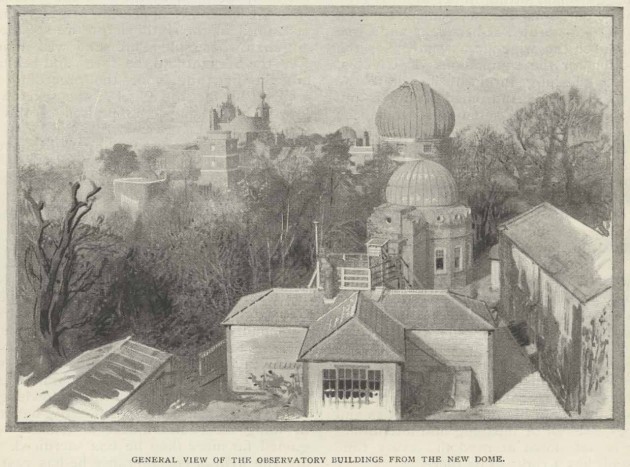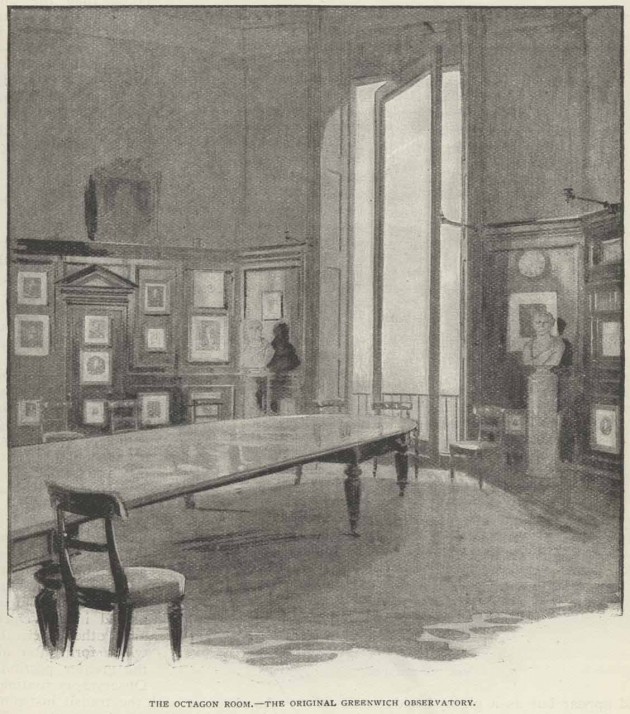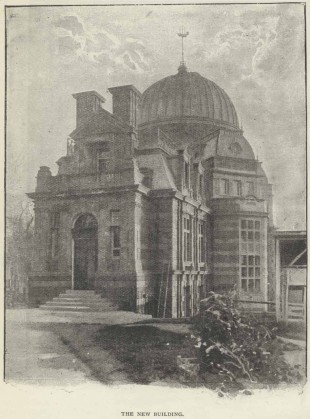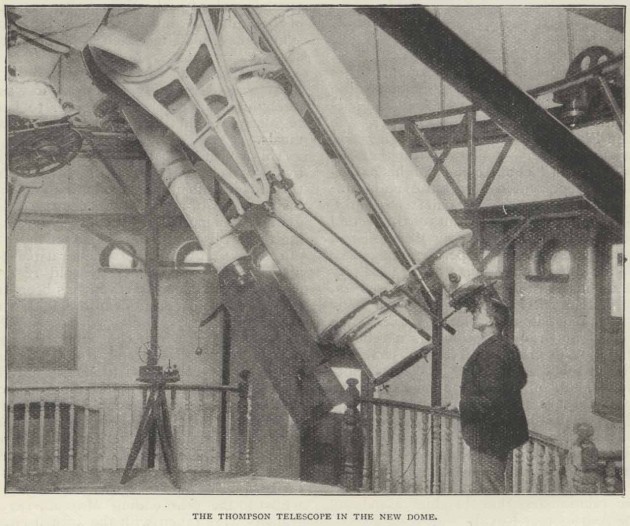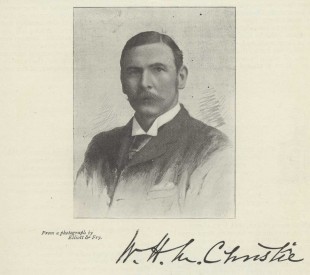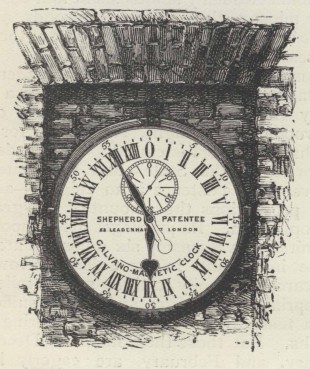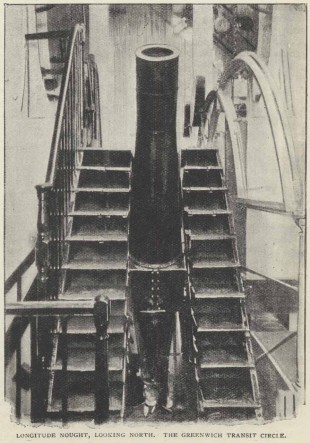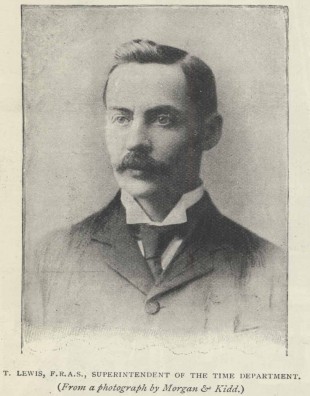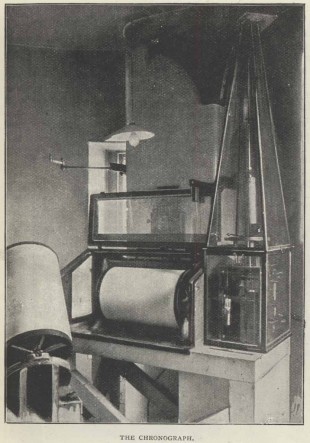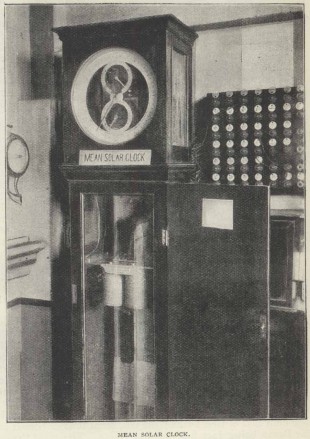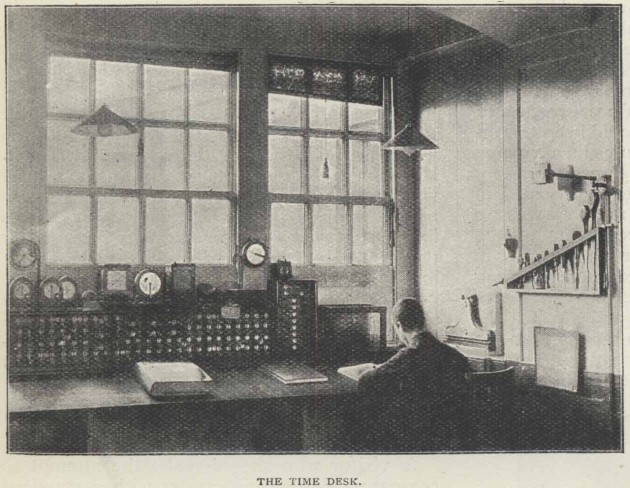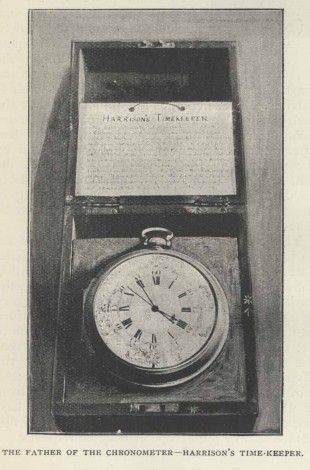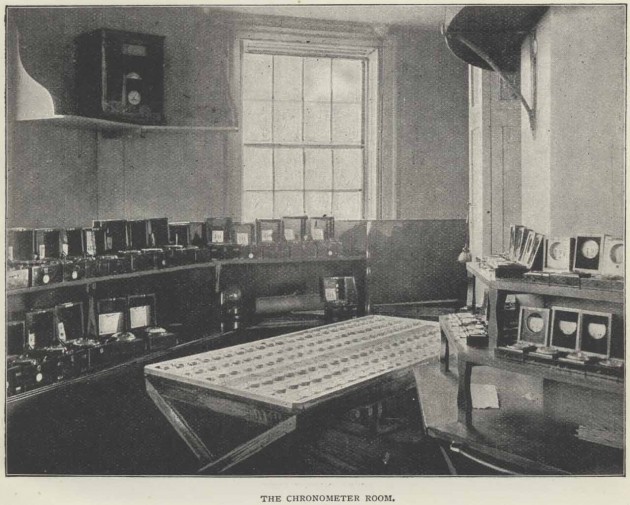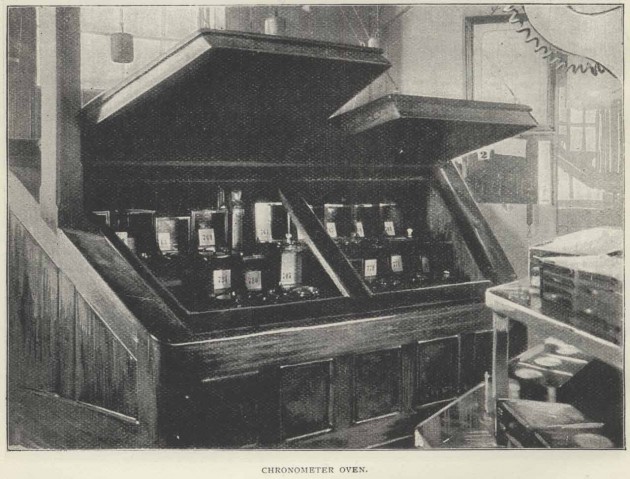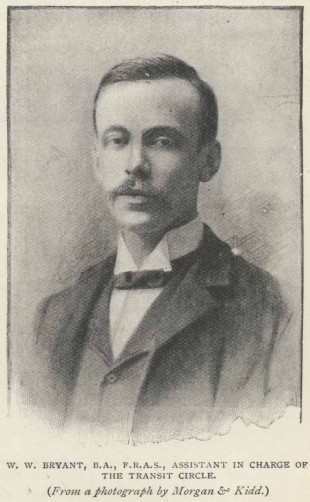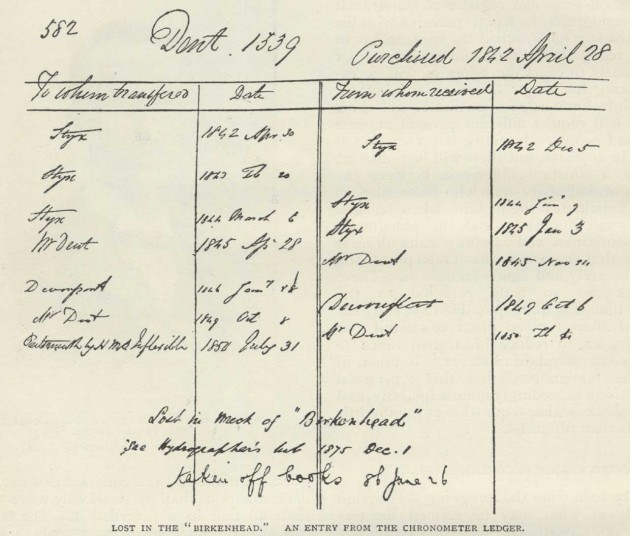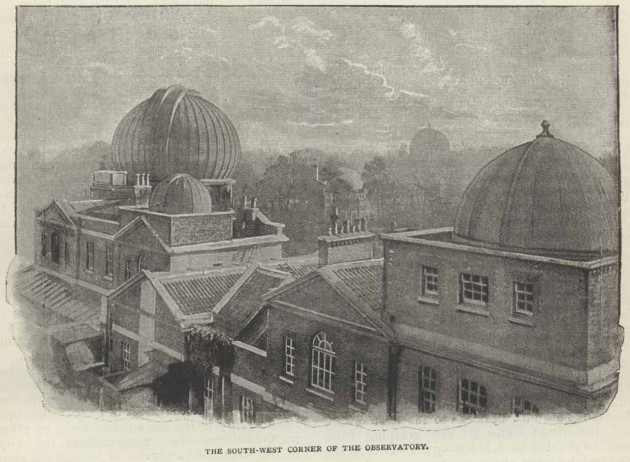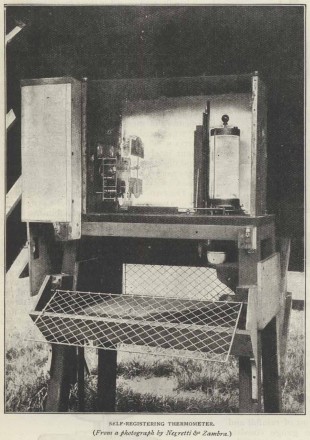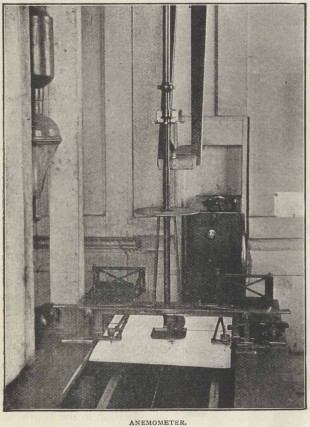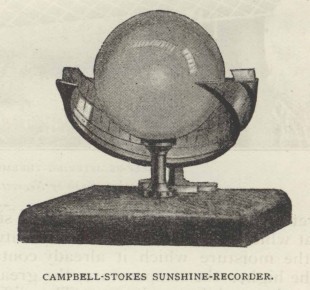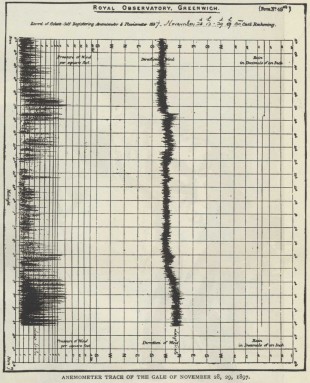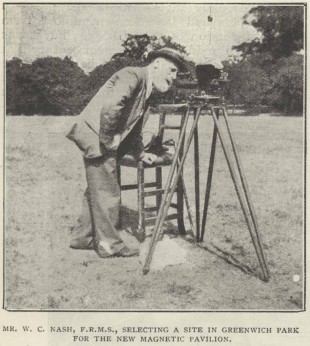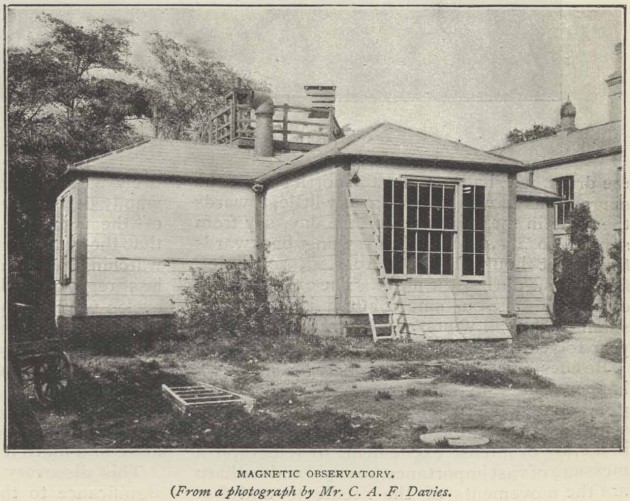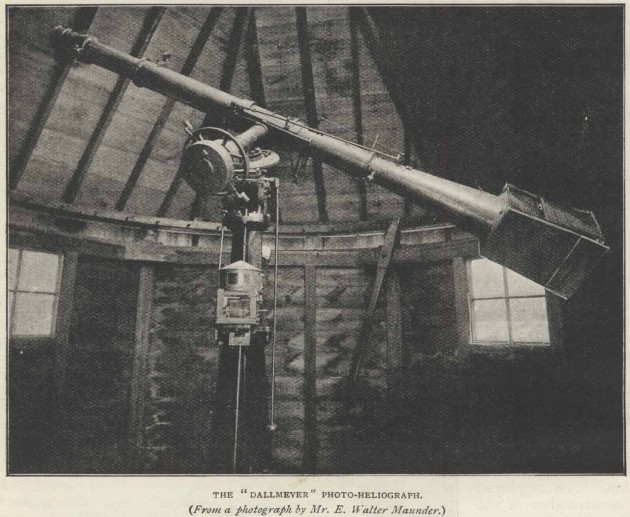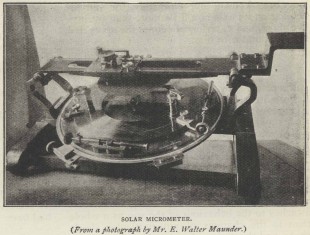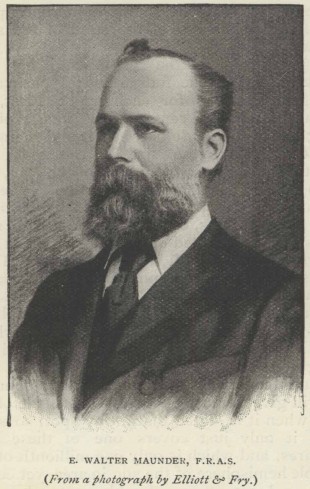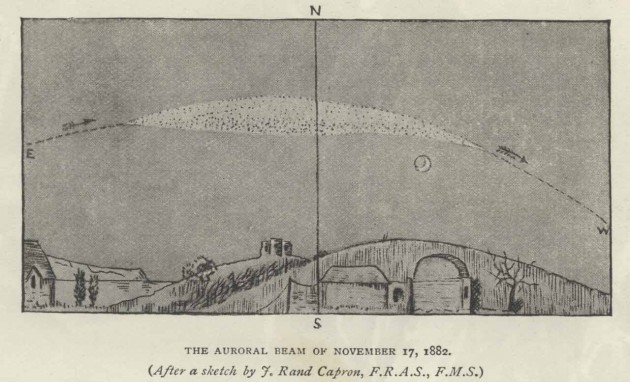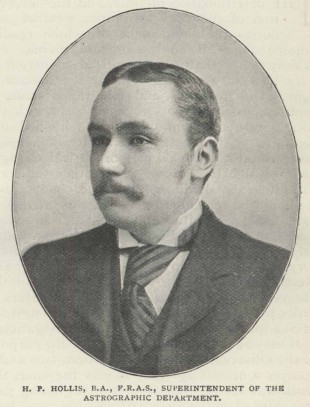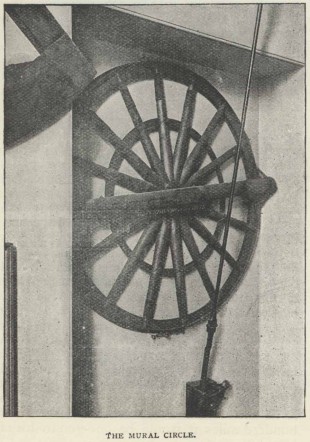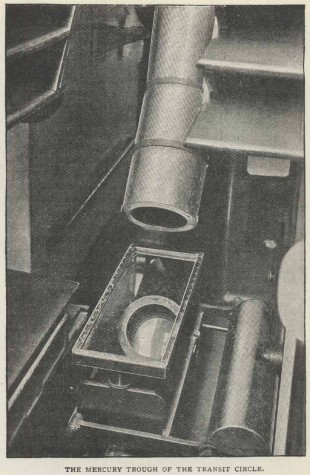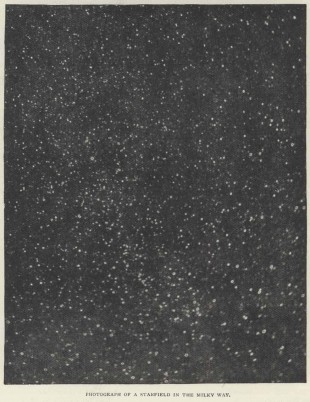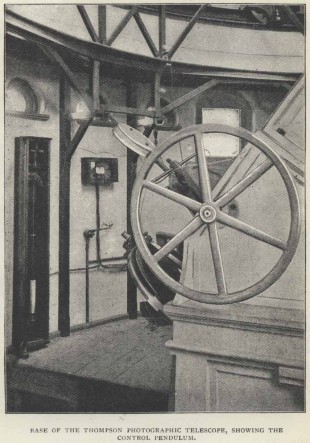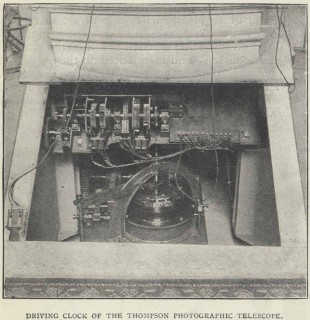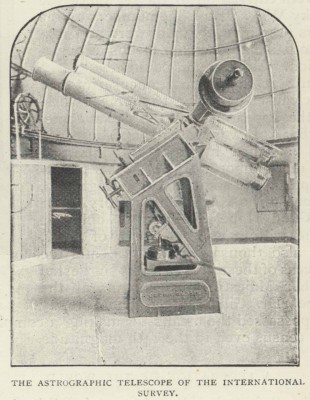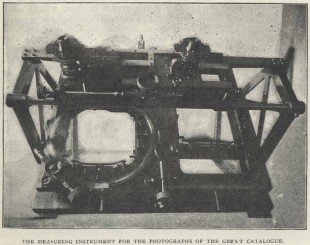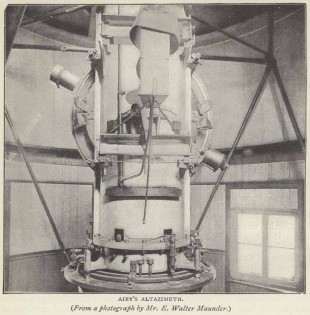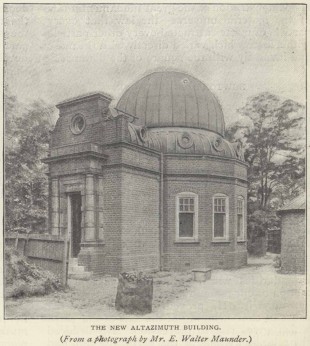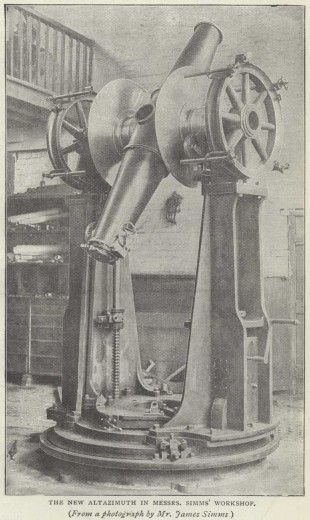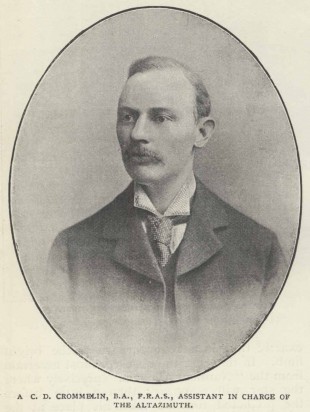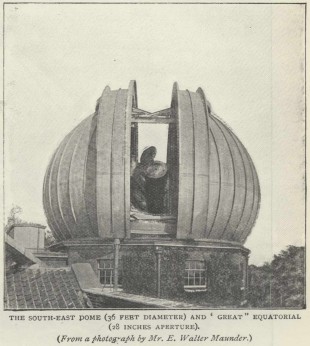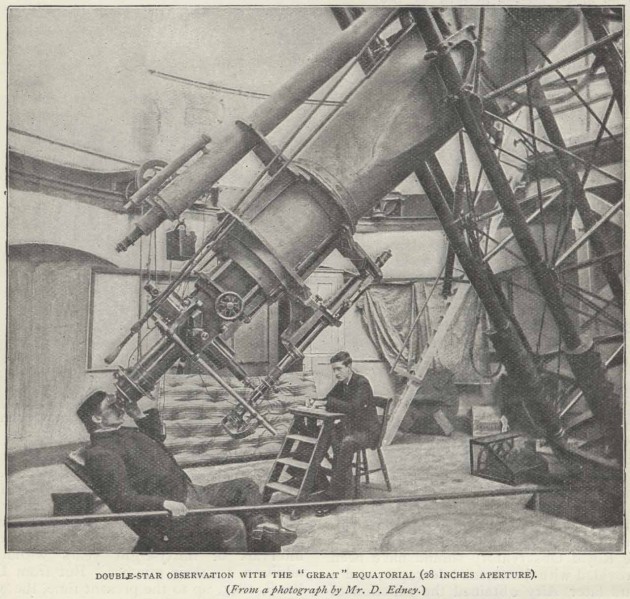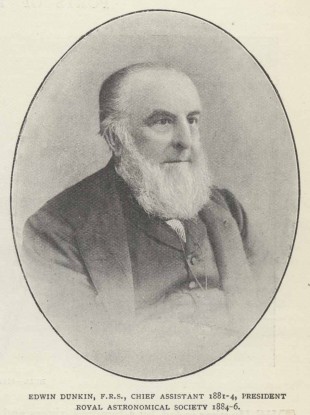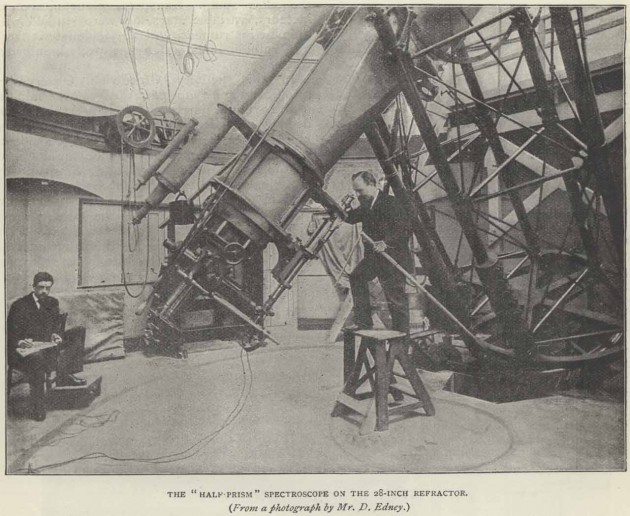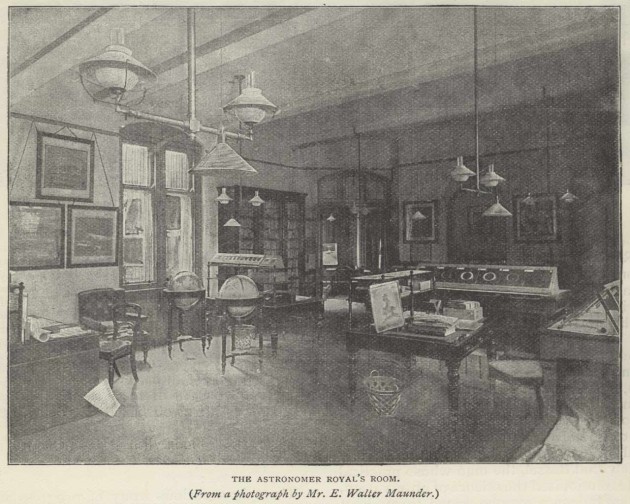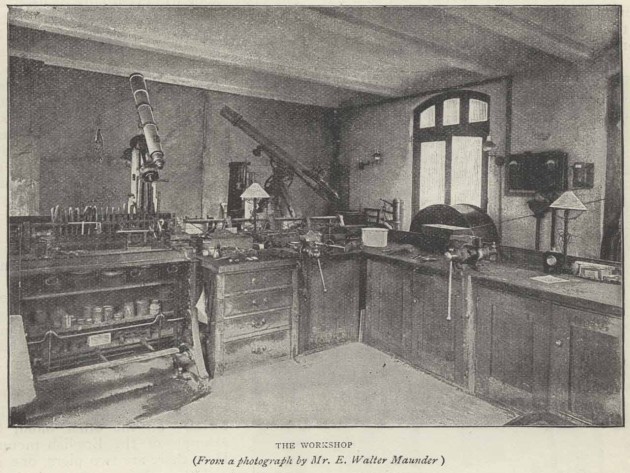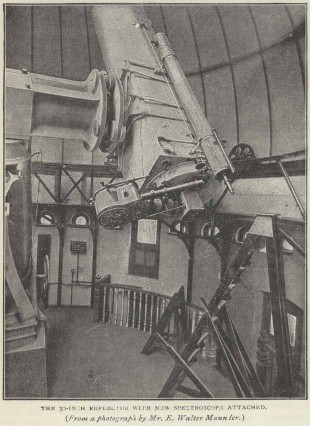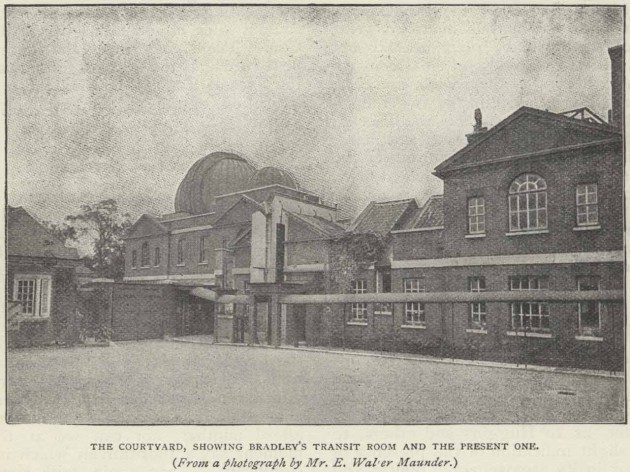…where east meets west
- Home
- Brief History
- The Greenwich Meridian
- Greenwich
(1675–1958) - Herstmonceux
(1948–1990) - Cambridge
(1990–1998) - Outstations (1822–1971)…
- – Chingford (1822–1924)
- – Deal
(1864–1927) - – Abinger
(1923–1957) - – Bristol & Bradford on Avon
(1939–1948) - – Bath
(1939–1949) - – Hartland
(1955–1967) - – Cape of Good Hope
(1959–1971)
- Administration…
- – Funding
- – Governance
- – Inventories
- – Pay
- – Regulations
- – Royal Warrants
- Contemporary Accounts
- People
- Publications
- Science
- Technology
- Telescopes
- Chronometers
- Clocks & Time
- Board of Longitude
- Libraries & Archives
- Visit
- Search
Contemporary account from 1897/98
| Date: | 1897/98 |
| Author: | E Walter Maunder, Assistant at the Royal Observatory |
| Title: | Greenwich Observatory |
| About: | Maunder wrote six articles about the Observatory which were published in eight episodes in the 1897/8 volume of The Leisure Hour (Religious Tract Society, London). The six articles were: 1.Origin (pp.152–160), 2.Longitude Nought (pp.228–238), 3. Storm and Sun (pp.293–297 &, 375–379), 4. Census of the sky (pp.561–565 & 642–646), 5. Bond of the Universe (pp.695–702) and 6. Celestial Chemistry (pp.771–776). Containing numerous images, the articles were later re-packaged into a single volume titled: The Royal Observatory Greenwich, a glance at its history and work (Religious Tract Society, London, 1900). Not all the images were reused. Although the 1900 volume has become a standard reference work, the 1897/8 articles are worth consulting for the additional material that they contain. |
| Images: | 47 |
[From The Leisure Hour 1897/98 (London), pp.152–160.]
GREENWICH OBSERVATORY
BY E WALTER MAUNDER, F.R.A.S.
ORIGIN OF THE OBSERVATORY.
THE debt which British commerce, and in its consequence, the welfare of Greater Britain, owes to astronomy is not generally and fully recognised. The ease and surety with which, to-day, thousands of miles of ocean are navigated, has ceased to excite any wonder. But even in the middle of the last century this was not so. Then the method of finding a ship's longitude at sea was the insufficient one of "Dead Reckoning," or the calculation of its position without the aid of the heavenly bodies. Of the disastrous consequences which might and often did follow in the train of this method by guesswork it is enough to cite the instance of the Commodore Anson. He wanted to make the island of Juan Fernandez and recruit his crew. He got into its latitude and ran eastward, believing himself to be west of the island. He was, however, really to its east, and made the Mainland of America. He had therefore to turn round and sail west wards, losing many days and very many of his men before gaining the island.
It was to help in the solution of this most pressing and practical problem of how to find a ship's place when at sea that Greenwich Observatory had its beginning. This question could be divided into two parts, the finding of the latitude and the finding of the longitude. The former could be found pretty easily. On the first fine night the ship's captain could measure the apparent height of the Pole Star above the horizon, and this in principle would give him his latitude; in practice there are several matters to be taken into consideration, with which we need not now deal. The knowledge of the longitude was more difficult to attain. It really involved that the captain must know the local time at the place where he was, and at the same moment the local time at the standard place – the standard place now almost universally adopted being Greenwich Observatory.
Greenwich time would easily be known if a thoroughly good chronometer which did not change its rate and which was set to Greenwich time before starting was carried on board the ship. At that time there were no chronometers or watches sufficiently good for the purpose, but Greenwich time could he ascertained in another way.
The moon moves pretty quickly amongst the stars, and in the " Nautical Almanac" of today its distance from a number of bright stars is given for every three hours of Greenwich time. It is possible then by measuring these distances, and making as in the case of the latitude certain corrections, to find out the time at Greenwich. In short, the whole sky may be considered as a vast clock set to Greenwich time, the stars being the numbers on the dial face, and the moon the hand (for this clock has only one hand) moving amongst them.
The local apparent time – that is the time at the place at which the ship itself was – is a simpler matter. It is noon at any place when the sun is due south – or, as we may put it a little differently, when it culminates – that is, when it reaches its highest point.
To find the longitude at sea, therefore, it was necessary to be able to predict precisely the apparent position of the moon in the sky for any time throughout the entire year, and it was also necessary that the places of the stars themselves should be very accurately known. It was therefore to gather the materials for a better knowledge of the motions of the moon and the positions of the stars that Greenwich Observatory was founded, whilst the " Nautical Almanac" was instituted to convey this information to mariners in a convenient form.
In Charles II’s time the necessary factors were however wanting. There were no exact chronometers; the position of the moon could not be predicted with sufficient precision, and the places of stars were not known with nearly enough exactness. The King, who, in spite of the evil reputation which he has earned for himself, took a real interest in science, was startled when this was reported to him, and commanded the man who had drawn his attention to these deficiencies "to apply himself," as the King's astronomer, "with the most exact care and diligence to the Rectifying the "Tables of the Motions of the Heavens and the Places of the Fixed Stars, in order to find out the so much desired Longitude at Sea, for the perfecting the Art of Navigation."
THE FIRST ASTRONOMER ROYAL.
This man, the Rev. John Flamsteed, was accordingly appointed first Astronomer Royal at the meagre salary of £100 a year, With full permission to provide himself with the instruments he might require at his own expense. He followed out the task assigned to him with extreme devotion amidst many difficulties and annoyances until his death in 1719. He has been succeeded by seven Astronomers Royal, each of whom has made it his first object to carry out the original scheme of the institution, and the chief purpose of Greenwich Observatory to-day, as when it was founded in 1675, is to observe the motions of the sun, moon, and planets, and to issue accurate star catalogues.
GREENWICH MEAN TIME.
The Observatory had been in existence nearly a century when the problem of the longitude was rendered much easier by the invention of the chronometer – a watch, that is, that might he trusted to keep accurate time for a long period amidst all the incidents of a sea voyage. This has rendered the care and rating of chronometers a very essential part of the Observatory work during its later history, and the "Time Department" is now one of the most; important. Besides the determination of time by the observation of sun and stars across the meridian, it includes the care of chronometers; and deck watches, of which at certain seasons more than 500 are here collected together; the furnishing daily time signals to the Post Office for distribution throughout the country, and dropping a Time-ball at 1 P.M. in order that the shipping in the docks and river may correct their chronometers. At one time the importance of this department to the Royal Navy threatened to have a very serious effect on the real scientific usefulness of the Observatory. For when Professor Airy succeeded to the direction, he found that of 840 letters in the official letter book 820 related to chronometers alone.
A NEW DEPARTURE.
Another department which, though it lay aside from the original purposes of the Observatory, as defined in the warrant given to Flamsteed, was yet intimately connected with navigation, was founded by Airy very early in his period of office. This dealt with the observation of the changes in the force and direction of the earth's magnetism, an inquiry which the greater delicacy of modern compasses, and, in more recent times, the use of iron instead of Wood in the construction of ships, has rendered imperative.
Weather forecasts, so necessary for the safety of the shipping round our coasts, are not issued from Greenwich Observatory, any more than the "Nautical Almanac" is issued from it. But just as the Observatory furnishes the astronomical data upon which the almanac is based, so also a considerable department is set apart for furnishing observations to be used by the Meteorological Office at Westminster for their daily predictions.
So far the development of the Observatory had been along the central line of assistance to navigation. But the "Magnetic Department” led on to a new one which had but a secondary connection with it. It had been discovered that the extent of the daily range of the magnetic needle, and the amount of the disturbances to which it was subjected, were in close connection with the numbers and size of the spots on the sun's surface. This led to the institution of a daily photographic record of the state of the sun's surface, a record of which Greenwich has now the complete monopoly.
THE PHOTOGRAPHIC STAR MAP.
More recently sill the work of making star catalogue, has entered upon an entirely new phase. The project has been brought forward of photographing the entire sky So as to secure a record of the places of far more star, than could be done by the ordinary methods, and in this project Greenwich has necessarily taken a premier place. This is work which, whilst it is the legitimate and natural outcome of the original purpose of the Observatory, is yet pushed beyond what is necessary for any mere utilitarian assistance to navigation. For the sailor it will always be sufficient to know the places of a mere handful of the brightest stars, and the vast majority of those in the great photographic map will never be visible in the little portable telescope of the sailor's sextant. But it will be freely admitted that in the case of all enterprises of this nature in which the observatories of so many different nations were uniting, and which was so precisely on the line of its original charter, though an extension of it, it was impossible for Greenwich to hold back on the plea that the work was not entirely utilitarian
THE MOST USEFUL BRANCH OF ASTRONOMY.
It is not every field of astronomy that is cultivated at Greenwich. The search for comets and for "pocket planets" forms no part of its programme; and the occupation so fascinating to those who take it up of drawing the details on the surfaces of the Moon, Mars, Jupiter, or Saturn, has been but little followed. Such work is here incidental, not fundamental, and the same may be said of certain spectroscopic observations of new or variable stars, and of many similar subjects. Work such as this is most interesting to the general public, and is followed with much devotion by many amateur astronomers. For that very reason it does not form all integral part of the programme of our State observatory. But work which is necessary for the general good, or for the advancement of the science, and which demands observations carried on continuously for many years, and strict unity of instruments and methods, cannot possibly be left to chance individual zeal, and is therefore rightly made the first object at Greenwich.
Those striking discoveries which from time to time appeal so strongly to the popular imagination, and which have rendered so justly famous some of the great observatories of the sister continent, have not often been made here.
Its work has, none the less, been not only useful but essential. A century ago, when we were engaged in the hand-to-hand struggle with Napoleon, by far the most brilliant part of that naval war which we waged against the French, and the most productive of prize-money, was carried on by our cruisers, who captured valuable prizes in every sea. But a much greater service, indeed an absolutely vital one, was, rendered to the State by those line-of-battle ships which were told off to watch the harbours wherein the French fleet was taking refuge. This was a work void of the excitement, interest, and profit of cruising. It was monotonous, wearing, and almost inglorious, but absolutely necessary to the very existence of England. So the continuance for more than two centuries of daily observations of places of stars and planets is likewise "monotonous, wearing, and almost inglorious”; the one compensation is that it is essential to the life of astronomy. So thorough has its work been that Professor Newcomb, the greatest living authority on the subject outside our own land, has said, "'The most useful branch of astronomy has hitherto been that which, treating of the positions and motions of the heavenly bodies, is practically applied to the determination of geographical positions on land and at sea. The Greenwich Observatory has, during the past century, been so far the largest contributor in this direction as to give rise to the remark that, if this branch of astronomy were entirely lost, it could be reconstructed from the Greenwich observations alone." Thus, for example, the star places determined by Bradley nearly one hundred and fifty years ago have been used quite recently to furnish the best values for the proper motions of stars yet available to us, and the observations made under Airy's direction in the present century have largely furnished the basis for that wonderful discovery of the shifting of the pole of the earth recently made by Professor Chandler in America.
A LIVING ORGANISM.
Like a living organism, Greenwich Observatory bears the record of its life-history, in its structure. It was not one of those favoured institutions that have sprung complete and fully equipped from the liberality of some great king or private millionaire. As we have seen, it was originally established on the most modest – not to say meagre – scale, and has been enlarged just as it has been absolutely necessary. To quote again from Professor Newcomb: “Whenever any part of it was found insufficient for its purpose, new rooms were built for the special object in view, and thus it has been growing from the beginning by a process as natural and simple as that of the growth of a tree. Even now the very value of its structure is less than that of several other public observatories, though it eclipses them all in the results of its work.”
THE "OCTAGON ROOM."
Flamsteed's little domain was only some twenty-seven yards wide by fifty deep, and for buildings comprised little beyond a small dwelling-house on the ground floor, and one fine room above it. This room – the original Greenwich Observatory – still remains and is used as a council room by the official Board of Visitors, who come down to the Observatory on the first Saturday in June, to examine into its condition and to receive the Astronomer Royal’s report. The room is called from its shape the Octagon Room, and is well known to Londoners from the great north window which looks out straight over the river between the twin domes of the Hospital.
In Bradley's time, about 1749, the first extension of the domains of the Observatory took place to the south and east of the original building, the direction it, which on the whole all subsequent extensions have taken place, owing o the fact that the Original building was constructed at the extremity of what Sir George Airy was accustomed to call a "peninsula" – a projecting spur of the Blackheath plateau, from which the ground falls away very sharply on three sides and on part of the fourth.
THE PRESENT DOMAIN.
The Observatory domain at present is fully two hundred yards in greatest length, with an average breadth of about sixty. Nearly the whole of this accession took Place under the directorates of Pond and Airy. The present instruments are therefore, as a rule, the more modern in direct proportion to their distance from the Octagon Room – the old original Observatory. There is one notable exception. The very first extension of the Observatory, made in the time of Halley, the second Astronomer Royal, consisted in the setting up of a strong pier to carry two quadrant telescopes. The pier still remains, but now forms the base of the support of the twin telescopes devoted to the photographic survey of the heavens for the International Chart.
This quadrant pier occupies tile most westerly of a range of buildings some forty-four yards in frontage, and built right, across the famous Greenwich meridian, the transit circle occupying their centre. At their eastern end the boundary turns sharply south, where stands a large octagonal building surmounted by a dome of oriental appearance, a “circular versatile roof” as the visitors would have called it a hundred years ago. This dome, which has been likened, according to the school of aesthetics in which its critics have been severally trained, to the Taj at Agra, a collapsed balloon, or a mammoth Spanish onion, houses the largest refractor in England, the “south-east equatorial” of twenty-eight inches aperture. But though the largest that England possesses, it would appear but as a pigmy beside some of the great telescopes for which America is famous.Beyond this dome the hollow devoted to the Astronomer Royal’s private garden reduces the Observatory ground to a mere “wasp’s waist,” a narrow inconvenient passage from the old and north observatory to the younger southern one.
The first building, as the grounds begin to widen out to the south, contains the new altazimuth, a transit instrument which can be turned into any meridian. A library of white brick and a low wooden cruciform building – the Magnetic Observatory – follow it closely. Then the ground widens out into an area about equal to that of the northern part, and the new building not yet completed, which will ere long have become emphatically “The Observatory,” stands clear before us. The transfer to this stately building of the computing rooms, libraries, and store rooms has been aptly described as a shift in the latitude of Greenwich Observatory, which still preserves its longitude. It may be noted that the only two buildings of any architectural pretensions in the whole range are-Flamsteed’s original observatory, built by Sir Christopher Wren, and containing little beyond the Octagon Room, in the extreme north; and this newest building in the extreme south.
COMPUTATION v. OBSERVATION.
This “new observatory,” like the old, and like the great south-eastern tower, is an octagon in its central portion. But whilst the other two great buildings are simply octagonal, here the octagon serves only as the centre from which will radiate four great wings to the four points of the compass. The building when complete will be by far the largest on the ground, but in little accord with the popular idea of an astronomer as perpetually looking through a telescope, carries but a single dome; its best rooms being set apart as “computing rooms,” for the use of those members of the staff who are employed in the calculations and other clerical work, which form after all much the greater portion of the Observatory routine.
An observer with the transit instrument, for instance, will take only three or four minutes to make a complete determination of the place of a single star. But that observation will furnish work to the computers for many hours afterwards. Or, to take a photograph of the sun will occupy about five minutes in setting the instrument, whilst the actual exposure will take but the one-thousandth part of a second. But the plate once exposed will have to be developed, fixed, and washed; then measured and the measures reduced, and, on the average, will provide one person with work for four days before the final results have been printed and published.
It is easy to see, then, that observing, though the first duty of the Observatory, makes the smallest demand on its time. The visitor who comes to the Observatory by day (and none are permitted to do so by night) finds the official rooms not unlike those of Somerset House or Whitehall, and its occupants for the most part similarly engaged, in what is apparently merely clerical work. An examination of the big folios would of course show that instead of being ledgers of sales of stamps, or income-tax schedules, they referred to stars, planets, and sunspots; but for one person actively engaged at a telescope, the visitor would see a dozen writing or computing at a desk.
THE STAFF.
The staff, like the building, is the result of a gradual development, and bears traces of its life history in its composition. First comes the Astronomer Royal, the representative and successor of the original “King's Astronomer,” the Rev. John Flamsteed. But the “single surly and clumsy labourer” which was all that the “Merry Monarch” could grant for his assistance, is now represented by a large and complex body of workers. Two “chief assistants” five “assistants,” two “assistants of the second class,” one “civil assistant,” four “established computers”, twenty-four “supernumerary computers,” a skilled mechanic, a vital necessity of such an institution, carpenters, labourers, porters, watchmen, messengers, in all some fifty persons, make up the entire personnel; each varied class and rank of which is a relic of some stage in the progress of the Observatory to its present condition. The chief assistants are the lieutenants of the Astronomer Royal; the assistants are severally charged each with the care of one of the departments into which the Observatory is, for convenience of work, divided; the civil assistant is practically secretary, accountant, and librarian; the established computers bear to certain of the assistants much the same relationship that the chief assistants do to the Astronomer Royal.
ARRANGEMENT OF THE WORK.
The day work, as said before, is by far the greatest in amount, the “office hours” being from nine to half-past four, with an hour’s interval. The arrangements for the night watches present some complications.
For many years the instruments in regular use were two only, the transit circle and the altazimuth. The arrangements for observing were simple. Four assistants divided them between them thus: an assistant was on duty with the transit circle one day, his watch beginning about six A.M. or a little later, and ending about three A. M. the following morning; a watch of twenty-one hours in maximum length. The second day his duties were entirely computational, and were only two or three hours in length. The third day he had a full day's work on the calculations, followed by a night duty with the altazimuth. The latter instrument might give him a very easy watch or a terribly severe one. If the moon were a young one it was easy, especially if the night was clear, as in that case an hour was enough to secure the observations required.
Very different was the case with a full moon, especially in the long, often cloudy, nights of winter. Then a vigilant watch had to be kept from sunset to sunrise, so that in case of a short break in the clouds the moon might yet be observed. Such a watch was the severest (with one exception) that an assistant had to undergo.
His fourth day would then resemble his second, and with the fifth day a second cycle of his quartan fever would commence, the symptoms following each other in the same sequence as before.
Such a routine carried on with iron inflexibility was exceedingly trying, as it was absolutely impossible for an observer to keep any regularity in his hours of rest or times for meals.
This routine has been considerably modified by the present Astronomer Royal, partly because the instruments now in regular daily use are five instead of two, and partly because a less stringent system has proved not merely far less wearing to the observers, but also much more prolific of results. It was impossible for a man to be at his best for long under the old regime, and from forty-six to forty-seven has been an ordinary age for an assistant to break down under the strain.
One point in which the observing work has been lightened has been in the discontinuance of the altazimuth observations at the full of the moon, another in the shortening of the hours of the transit circle watch; and a further and most important one in the arrangement that the observers with the larger instruments should have help at their work. The net result of these changes has been a most striking increase in the amount of work achieved. Thus whilst in the year ending May 20, 1875, 3,780 transits were taken with the transit circle, and 3,636 determinations of north polar distance; in that ending May 10, 1895, the numbers had risen to 11,240 and 11,006 respectively, the telescope remaining precisely the same.
One principle of Airy's rule still remains. So far as possible no observer is on duty for two consecutive days, but a long day of desk work and observing is followed by a short day of desk work without observing.
It will be readily understood that with five principal telescopes in constant work and one or two minor ones, some demanding two observers, others only one, each telescope having its special programme and its special hours of work, whilst by no means every member of the staff is authorised to observe with all instruments indifferently, it becomes a somewhat intricate matter to arrange the weekly rota in strict accordance with the foregoing principle, and with the further one, that whilst a considerable amount of Sunday observing is inevitable, the average duties of an observer should be three days a week, not seven days a fortnight. 'There is a story, received with much reserve at Cambridge, that there was once a man at that university who had mastered all the colours and combinations of shades and colours of the various colleges and clubs. If so gifted a being ever existed he may be paralleled by the Greenwich assistant who can predict for any future epoch the sequence of duties throughout the entire establishment. At any rate, one of the first items in the week's programme is the preparation of the rota for the week, or rather, to use an ecclesiastical term, for the "octave," i.e. from the Monday to the Monday following.
The special work to be carried out on any telescope is likewise a matter of programme. For the transit circle a list of the most important objects to be observed is supplied for the observer's use, and the general lines upon which the other stars are to be selected from a huge "Working Catalogue" are well understood. With some of the other telescopes the principles upon which the objects are to be selected are laid down, but the actual choice is left to the discretion of the observer at the time. There is no time for the watcher to spend in what the outsider would regard as "discovery"; such as sweeping for comets or asteroids, hunting for variable stars, sketching planets, and so forth. Indeed, there is a story current in the "Observatory" that some fifty years ago, when the tide of asteroid discovery first set in, Airy found an assistant, since famous, working with a telescope on his "off-duty" night. That stern disciplinarian asked what business the assistant had to be there on his free night, and on being told he was "searching for new planets," he was severely reprimanded and ordered to discontinue at once. A similar energy would not meet so gruff a discouragement to-day; but the routine work so fully occupies both staff and telescopes that an assistant may be most thoroughly devoted to his science, and yet pass a decade at the Observatory without ever seeing those "show places" of the sky, which an amateur would have run over in the first week after receiving his telescope. For example, there is no refractor in the British Isles so competent to bring out the vivid green light of the great Orion nebula – that marvellous mass of glowing curdling emerald cloud – or the indescribable magnificence of the myriad suns that cluster like swarming bees or like the grapes of Eschcol in the constellation of Hercules; yet probably most of the staff have never seen either spectacle through it. The professional astronomer who is worth his salt will find abundance of charm and interest in his work, but he will not, " Like a girl Valuing the giddy pleasures of the eyes,” consider the charm to lie mainly in the occasional sight of wonderful beauty which his work may bring him, nor the interest in some chance phenomenon which may make his name known.
THE BOARD OF VISITORS.
The eight astronomers Royal have, as already said, kept the Observatory strictly on the lines originally laid down for it, subject of course to that enlargement which the growth of the science has inevitably brought. But had they been inclined to change its course, there is a body specially appointed to bring them back to the right way. The Board of Visitors dates from 1710, when it practically consisted of the President and Council of the Royal Society. Now its constitution is wider. The President of the Royal Society is still its Chairman, but the Admiralty, of which the Observatory is a department, the two Universities of Oxford and Cambridge, and the Royal Astronomical Society are all represented on it by ex officio members, and twelve other members are contributed by the Royal and Royal Astronomical Societies respectively, six by each. The first Saturday in June is the appointed day for the annual inspection by the Board, and for the presentation to it of the Astronomer Royal’s report. This all-important business meeting has been added something of a social function by the invitation of many well-known astronomers and the leading men of the allied sciences to inspect the results of the year, and to partake of the chocolate and cracknels, which have been the traditional refreshments offered on these occasions for a period " whereof the memory of man runneth not to the contrary.'At present, and for many years past, the relations of Astronomer Royal and Board have been of the smoothest. It has not always been so. The last years of Flamsteed's directorate , were embittered by a struggle between the Board and himself, in which much was to be said for his view of his case. His salary was entirely insufficient even for the necessary expenses of his office; his instruments were provided at his own expense, his observations were made chiefly by himself, his payments out of his own pocket to assistants or for instruments during his time office exceeded £2,000; and he naturally thought that the property in observations made at so much expense of his money, time, and strength, rested with himself. Besides, he doubted if the Board would publish them with accuracy. The board, on the other hand, urged that the Observatory existed for the nation, and that the observations made therein belonged to it and were for its benefit.
The Board was right; hardly as their action bore upon Flamsteed. But it must be remembered that the guilt of the injustice under which he suffered rested not upon the Board but upon the Government, which gave him such a mockery of support.
A HALF-FORGOTTEN ASTRONOMER.
The first Astronomer Royal, who was so scurvily treated during his lifetime, has not yet received anything like the meed of appreciation which is his just due. His successors in the office have not forgotten him. They have been proud that their official residence should be known as "Flamsteed House," and his name is inscribed over the main entrance of the latest and finest of the Observatory buildings, and his bust looks forth from its front towards the home where he laboured so devotedly for nearly fifty years. But he has received little honour, save at Greenwich, and – in spite of the proverb – in his other home, the village of Burstow in Sussex, of which he was for many years the rector. Here a stained-glass window, representing appropriately the "Adoration of the Magi," has been recently set up to his memory; largely through the interest taken in his history by an amateur astronomer of the neighbourhood, Mr. W. Tebb, F.R.A.S.
Still, Flamsteed's Board was right in its contention – at any rate so far as the principle was concerned. The Observatory is for the service of the nation. It is not for the pursuit of any private line of inquiry; nor is it, to quote the late Astronomer Royal, "the place for new physical investigations." "It is well adapted," as he went on to say, "for following out any which, originating with private investigators, have been reduced to laws susceptible of verification by daily observation.” Where routine work, carried out for a long succession of years on one carefully considered plan, is required, there the Royal Observatory finds its opportunity and its duty. Above all, its distinction lies in the faithful continuance of those observations which have not only built up the very structure of geometrical astronomy, but have borne directly on the welfare, we might almost add the existence, of the nation.
[From The Leisure Hour 1897/98 (London), pp.228–238.]
LONGITUDE NOUGHT.
ONE day two Scotchmen stood just outside the main entrance of Greenwich Observatory, looking intently at the great twenty-four hour clock, which is such an object of attention to the passers through the Park “Jock," said one of them to the other, " d'ye ken whar ye are?" Jock admitted his ignorance. " Ye are at the vara ceentre of the airth."Geographers tell us that there is a sense in which this statement as it stands may be accepted as true. For if the surface of the globe be divided into two hemispheres, so related to each other that the one contains as much land as possible, and the other as little, then London will occupy the centre or thereabouts of the hemisphere with most land.
"This was not, however, what the Scotchman meant. He meant to tell his companion that he was standing on the prime meridian of the world, the imaginary base line from which all distances, east or west, are reckoned; in short, that he was on "Longitude Nought."
He was not absolutely correct, however, for the great twenty-four hour clock does not mark the exact meridian of Greenwich. To find the instrument which marks it out and defines it we must step inside the Observatory precincts, and just within the gate we see before us on the left hand a door which leads through a little lobby straight into the most important room of the whole Observatory – the Transit Room.
THE TRANSIT ROOM.
This room is not well adapted for representation by artist or photographer. Four broad stone pillars occupy the greater part of the space and leave little more than mere passage room beside. Two of these pillars are tall as well as broad and massive, and stand east and west of the centre of the room, carrying between them the fundamental instrument of the Observatory, the Transit Circle. The optical axis of this telescope marks "Longitude Nought," which is further continued by a pair of telescopes, one to the north of it, the other to the south, mounted on the third and fourth of the pillars alluded to above.This room has not always marked the meridian of Greenwich, for it stands outside the original boundary of the Observatory. But it is only a few feet to the east of the first transit instrument which was set up by Halley, the second Astronomer Royal, in the extreme N.W. corner of the Observatory domain, a distance equivalent to very much less than one tenth of a second of time, an utterly insensible quantity with the instruments of two hundred years ago.
It would be a long story to tell in detail how the Greenwich Transit Room has come to define one of the two fundamental lines that encircle the earth. The other, the equator, is fixed for us by the earth itself, and is independent of any political considerations, or of any effort or enterprise of man. But of all the infinite number of great circles which could be drawn at right angles to the equator, and passing through the north and south poles, it was not easy to select one with such an overwhelming amount of argument in its favour as to obtain a practically universal acceptance. The meridians of Jerusalem and of Rome have both been urged upon what we may call religious or sentimental grounds; that of the Great Pyramid at Ghizeh has been pressed in accordance with the fantastic delusion that the Pyramid was erected under Divine inspiration and direction; that of Ferrol, in the Azores, as being an oceanic station, well to the west of the Old World, and as giving a base line -which gave no preference or distinction to one nation rather than another.
“THE EXPANSION OF ENGLAND.”
The actual decision has been made upon no such ground as these. It has been one of pure practical convenience, and has resulted from the amazing growth of Great Britain as a naval and commercial power. Like Tyre of old, she is "situate at the entry of the sea, a merchant of the people for many isles," and "her merchants are the great men of the earth." To tell in full therefore tile Steps by which the Greenwich meridian has overcome all others is practically to tell again from a different Standpoint the Story of the "Expansion of England." The need for a supreme navy, the development of our empire beyond the seven seas, the vast increase of our carrying trade, these have made it necessary that Englishmen should be well supplied with maps and charts. The hydrographic and geographic surveys carried out either officially by this country, or by Englishmen in their own private capacity, have been so numerous, complete, and far reaching as not only to outweigh those of all other countries put together, but have induced the surveyors and explorers of not a few other countries to adopt in their work the same prime meridian as that which they found in the British charts of regions bordering on those which they were themselves studying. Naturally the meridian of Greenwich has not only been adopted for Great Britain, but also for the British possessions over-sea, and from these for a large number of foreign countries, whilst our American cousins retain it, an historic relic of their former political connection with us. The victories of Clive at Arcot and Plassy, of Nelson at the Nile and Trafalgar, the voyages and surveys of Cook and Flinders, and many more; the explorations of Bruce, Park, Livingstone, Speke, Cameron, and Stanley; these are some of the agencies which have tended to fix "Longitude Nought" in the Greenwich Transit Room.
There are two somewhat different senses in which the meridian of Greenwich is the standard meridian for nearly the entire world. The first is the sense about which we have already been speaking; it constitutes the fundamental line whence distances east and west are measured, just as distances north and south are measured from the equator. But there is another, though related sense, in which it has become the standard. It gives the time to the world.
SIX KINDS OF TIME.
There are few questions more frequently put than, "What time is it?” "Can you tell me the true time?" A stickler for exactitude might reply, " What kind of time do you mean?" "Do you mean solar or sidereal time?" “Apparent time or mean time?" "Local time or standard time?" There are all these six kinds of time, not to speak of others. It is only within the last two generations, within indeed the reign of our Sovereign, Queen Victoria, that the subject of the differences of most of these kinds of time has become of pressing importance to any but theorists.
In one of the public gardens of Paris a little cannon is set up with a burning-glass attached to it in such a manner that, the sun itself fires the cannon as it reaches the meridian. This, of course, is the time of Paris noon – apparent noon – -but it would he exceedingly imprudent of any traveller through Paris who wished, say, to catch the one o'clock express, to set his watch by the gun. For if it happened to be in February, he would find when lie reached the railway station that the station clock was faster than the sun by nearly a full quarter of an hour, and that his train had gone; whilst towards the end of October or the beginning of November, he would find himself as much too soon.
Until machines for accurately measuring time were invented, apparent time-time, that is to say, given by the sun itself, as by a sun-dial was the only time about which men knew or cared. But when reasonably good clocks and watches were made, it was very soon seen that at different times in the year there was a marked difference between sun-dial time and that shown by the clock, the reason being simply that the apparent rate of motion of the sun across the sky was not always quite the same, whilst the movement of the clock was, of course, as regular as it could be made.
We had thus early in the century the two kinds of time in common use, apparent time and mean time, or clock time. But as the sun can only be on one particular meridian at any given instant, the time as shown by the clocks in one particular town will differ from that of another several miles to the east or west of it. It is thus noon at Moscow 1 hr. 36 min. before it is noon at Berlin, and noon at Berlin 54 min. before it is noon in London.
“RAILWAY” TIME.
This was all well enough known, but occasioned no inconvenience until the introduction of railway travelling; then a curious difficulty, arose. Suppose an express train was running at the rate of sixty miles an hour from London to Bristol. The guard of the train sets his watch to London time before he leaves Paddington, but if the various towns through which the train passes, Reading, Swindon, etc., each keep their own local time, he will find his watch apparently fast at each place he reaches; but on his return journey, if he sets to Bristol time before starting, he will in a similar way find it apparently slow by the Swindon, Reading, and Paddington clocks as he reaches them in Succession.
It became at once necessary to settle upon one uniform system of time for use in the railway guides. Apart from this, a passenger taking train, say, at Swindon, might have been very troubled to know whether the advertised time of his train was that of Exeter, the place whence it started, or Swindon, the station where he was getting in, or London, its destination. "Railway time," therefore, was very early fixed for the whole of Great Britain to be the same as London time, which is, of course, time as determined at Greenwich Observatory. At first it was the custom to keep at the various stations two clocks, one showing local time, the other "railway," or Greenwich time, or else the clocks would be provided with a double minute hand, one branch of which pointed to the time of the place, the other to the time of Greenwich.It was soon found, however, that there was no sufficient reason for keeping up local time. Even in the extreme West of England the difference between the two only amounted to twenty-three minutes, and it was found that no practical inconvenience resulted from saying that the sun rose at twenty-three minutes past six on March 22, rather than at six o'clock. The hours of work and business were practically put twenty-three minutes earlier in the day, a change of which very few people took any notice.
Other countries besides England felt the same difficulty and solved it in the same way, each country as a rule taking as its standard time the time of its own chief city.
DIFFICULTIES OF AMERICAN TIMES.
There were two countries for which this expedient was not sufficient – the United States and Canada. The question was of no importance until the iron road had linked the Atlantic to the Pacific in both countries. Then it became pressing. No fewer than seventy different standards prevailed in the United States only some fifteen years ago. The case was a very different one here from that of England, where east and west differed in local time by only a little over twenty minutes. In North America, in the extreme case, the difference amounted to four hours, and it seemed asking too much of men to call eight o'clock in their morning, or it might be four o'clock in their afternoon, their noonday.
The device was therefore adopted of keeping the minutes and seconds the same for all places right across the continent, but of changing the hour at every 15º of longitude. The question then arose what longitude should be adopted as the standard. The Americans might very naturally have taken their standard time from their great national Observatory at Washington, or from that of their chief city, New York, or of their principal central city, Chicago. But, guided partly no doubt by a desire to have their standard times correspond directly to the longitudes of their maps, and partly from a desire to fall in if possible with some universal time scheme, if such could be brought forward, they fixed upon the meridian of Greenwich as their ultimate reference line, and defined their various hour standards as being exactly so many hours slow of Greenwich mean time.
The decision of the United States and of Canada brought with it later a similar decision on the part of all the principal States of Europe; and Greenwich is not only "Longitude Nought" for the bulk of the civilised world, but Greenwich mean time increased or decreased by an exact number of hours or haltf-hours as the standard time all over the planet.
No, the statement requires correction. Two countries hold out, both close to out- own doors. France, instead of adopting Greenwich time as such, adopts Paris time less 9m. 21s. (that being the precise difference in longitude between the two national Observatories). Ireland disdains even such a veiled surrender, and Dublin time is the only one recognised from the Hill of Howth to far Valentia. So the distressful country preserves her old grievance, that she does not even get her time until after England has been served.
The alteration in national habits following on the adoption of this European system has had a very perceptible effect in some cases. Thus Switzerland has adopted Mid-European time, one hour fast of Greenwich; the true local time for Berne being just half an hour later. The result of putting the working hours this thirty minutes earlier in the day has had such a noticeable effect on the consumption of gas, as to lead the gas company to contemplate agitating; for a return to the old system.
Thus Greenwich time as well as the Greenwich meridian has practically been adopted the world over.
HOW TIME IS FOUND.
It goes without saying, then, that the determination of time is one of the most important duties of the Royal Observatory, and it may be well worth our while to note the process.
Entering the Transit Room, the first thing that strikes the visitor is the extreme solidity with which the great telescope is mounted. It turns but in one plane, that of "longitude nought," and its pivots are supported by the pair of great stone pillars which we have already spoken of as occupying the principal part of the Transit-Room area, and the foundations of which go deep down under the surface of the hill. On the west side of the telescope, and rigidly connected with it, is a large wheel some six feet in diameter, and with a number of wooden handles attached to it, resembling the steering-wheel of a large steamer. This wheel carries the setting circle, which is engraved upon a band of silver let into its face near its circumference, a similar circle being at the back of the wheel nearer the pillar. Eleven microscopes, of which only seven are ordinarily used, penetrate through the pier, and are directed on to this second circle.
The watcher who wishes to observe the passing of a star must note two things: he must know in what direction to point his telescope, and at what time to look for the star. Then, about two minutes before the appointed time, he takes his place at the eye-piece. As he looks in he sees a number of vertical lines across his field of view. These are spider-threads placed in the focus of the eye-piece. Presently, as he looks, a bright point of silver light, often surrounded by little flashing vibrating rays of colour, comes moving quickly, steadily, onward – “swims into his ken," as the poet has it. The watcher's hand seeks the side of the telescope till his finger finds a little button, over which it poises itself to strike. On comes the star, " without haste, without rest," till it reaches one of the gleaming threads. Tap! The watcher's finger falls sharply on the button. Some three or four seconds later and the star has reached another "wire," as the spider-threads are commonly called. Tap! Again the button is struck. Another brief interval and the third wire is reached, and so on, until ten wires have been passed, and the transit is over. The intervals are not, however, all the same, the ten wires being grouped into three sets, two of three apiece, and the third of four.
Each tap of the observer's finger completed for an instant an electric circuit, and recorded a mark on the "chronograph." This is a large metal cylinder covered with paper, and turned by a carefully regulated clock once in every two minutes. Once in every two Seconds a similar mark was made by a current sent by the means of the standard sidereal clock of the Observatory. The paper cover of the chronograph after an hour's work shows a spiral trace of little dots encircling it some thirty times. These dots are at regular intervals about an inch apart, and are the marks made by the clock. Interspersed between them are certain other dots, in sets of ten; and these are the signals sent from the telescope by the transit observer. If, then, one of the clock dots and one of the observer's dots come exactly side by side, we know that the star was on one of the wires at a given precise second. If the observer's dot comes between two clock dots, it is easy, by measuring its distance from them with a divided scale, to tell the instant the star was on the wire to the tenth of a second, or even to a smaller fraction. Whilst, since the transit was taken over ten wires, and the distance of each wire from the centre of the field of view is known, we have practically ten separate observations, and the average of these will give a much better determination of the time of transit than a single one would.
A LESSON IN PUNCTUALITY.
But let the watcher be ever so little too slow in setting his telescope, or ever so little late in placing himself at his eye-piece, and the star will have passed the wire, and as it smoothly, resistlessly moves on its inexorable way, will tell the tardy watcher in a language there is no mistaking, "Lost moments can never be recalled." The opportunity let slip, not until twenty-four hours have gone by will another chance come of observing that same star.
It is the stars that are chiefly used in this determination, partly because the stars are so many, whilst there is but one sun. If, therefore, clouds cover the sun at the important moment of transit, the astronomer may well exclaim, so far as this observation is concerned, "I have lost a day!" The chance will not be offered him again until the following noon. But if one star is lost by cloud, there are many others, and the chance is by no means utterly gone. Beside, the sun enables us to tell the time only at noon; the stars enable us to find it at various times throughout the entire night; indeed, throughout both day and night, since the brighter stars can be observed in a large telescope even during the day.
THE TWO GREAT TIME-KEEPERS.
There are two great standard clocks at the Observatory: the mean solar clock and the sidereal clock. The latter registers twenty-four hours in the precise time that the earth rotates on its axis. A "day" in our ordinary use of the term is somewhat longer than this; it is the average time from one noon to the next, and as the earth whilst turning round on its axis is also travelling round the sun, it has to rather more than complete a rotation in order to bring the sun again on to the same meridian. A solar day is therefore some four minutes longer than an actual rotation of the earth, i.e. a sidereal day, as it is called, since such rotation brings a star back again to the same meridian.The sidereal clock can therefore be readily checked by the observation of star transits, for the time when the star ought to be on the meridian is known. If, therefore, the comparison of the transit taps on the chronograph with the taps of the sidereal clock show that the clock was not indicating this time at the instant of the transit, we know the clock must be so much fast or slow. Similarly the difference which should be shown between the sidereal and solar clocks at any moment is known: and hence when the error of the sidereal clock is known, that of the solar can be readily found.
KEEPING THE STANDARD CLOCK UP TO TIME.
It is often quite sufficient to know how much a clock is wrong without actually setting its hands right; but it is not possible to treat the Greenwich clock so, for it controls a number of other clocks continually, and sends hourly, signals out over the whole country, by which the clocks and watches all over the kingdom are set right.
The means, therefore, is provided for setting the clock right very easily and exactly. In the Lower Computing Room, below the south window, are a range of little dials and bright brass knobs that almost suggest the stops of a great organ. Two of these little dials are clock faces, electrically connected with the solar and sidereal standard clocks, so that, though these clocks are themselves a good way off in entirely different parts of the Observatory, the time superintendent, seated here at the time desk, can see at once what they are indicating. Between the two is a dial labelled "Commutator." From this dial a little handle usually hangs vertically downwards, but it can he turned either to the right or to the left, and when thus switched hard over, an electric current is sent through to the mean solar clock. If now we leave the Computing Room and cross the courtyard to the extreme north-west corner, we find the mean solar clock in a little lobby carefully guarded by double doors and double windows against rapid changes of temperature. Opening the door of the clock case, we see that the pendulum carries on its side a long steel bar, and that this bar as the pendulum swings passes just over the upper end of an electromagnet. When the Current is switched on at the commutator, this electro-magnet attracts or repels the steel bar according to the direction of the current, and the action of the clock is accordingly quickened or retarded. To put the commutator in action for one minute will alter the clock by the tenth of a second. As the error of the clock is determined twice a day, shortly before ten o'clock in the morning and shortly before one o'clock in the afternoon, its error is always small, usually only one or two tenths. These two times are chosen because, though time signals are sent over the metropolitan area every hour from the Greenwich clock through the medium of the Post Office, at ten and at one o'clock signals are also sent to all the great provincial centres. Further, at one o'clock the time balls at Greenwich and at Deal are dropped, so that the captains of ships in the docks on the river or in the downs may check their chronometers.The time ball is dropped directly by the mean solar clock itself. It is raised by means of a windlass turned by hand power to the top of its mast just before one o'clock. Connected with it is a piston working in a stout cylinder. When the ball has reached the top of the mast, the piston is lightly supported by a pair of catches. These catches are pulled back by the hourly signal current, and the piston at once falls sharply, bringing the ball with it. But after a fall of a few feet, the air compressed by the piston acts as a cushion and checks the fall, the ball then gently and slowly finishing its descent. The instant of the beginning of the fall is, of course, the true moment to be noted.
The other dials on the time desk are for various purposes connected with the signals. One little needle in a continual state of agitation shows that the electric current connecting the various sympathetic clocks of the Observatory is in full action. Another receives a return signal from various places after the despatch of the time-signal from Greenwich, and shows that the signal has been properly received at the distant station, whilst all the many electric wires within the Observatory or radiating from it are made to pass through the great key-board where they can be at once tested, disconnected, or joined up, as may be required.
THE FIRST CHRONOMETER.
The distribution of Greenwich time over the island in this way is thus a simple matter. The far more important one of the distribution of Greenwich time to ships at sea is more difficult. The difficulty lay in the construction of a clock or a watch, the rate of which would not be altered by the uneasy motion of a ship, or by the changes of temperature which are inevitable on a voyage. Two hundred years ago it, was not deemed possible to construct a watch of anything like sufficient accuracy. They would not even keep going whilst they were being wound, and would lose or gain as much as a minute in the day for a rise or fall of 10º in temperature. This was owing to the extreme sensitiveness of the balance spring – which takes the place in a watch of a pendulum in a clock – to the effects of temperature. The British Government, therefore, in 1714 offered a prize of the amount of £20,000 for a means of finding the longitude at sea within half a degree, or, in other words, for a watch that would keep Greenwich time correct to two minutes in a voyage across the Atlantic. In 1735, James Harrison, the son of a Yorkshire carpenter, succeeded in solving the problem. His method was to attach a sort of automatic regulator to the spring which should push the regulator over in one direction as the temperature rose, and bring it back as it fell. This he effected by fastening together two strips of brass and steel. The brass expanded with heat more rapidly than the steel, and hence with a rise of temperature the strip bent over on the steel side. This was the first germ of the idea of making watches "compensated for temperature," watches, that is, which maintain practically the same rate whether they are in heat or cold, and which is now brought to such perfection in the modern chronometer.The great reward the Government had offered stimulated many men to endeavour to solve the problem. Of these, Dr. Halley, the second Astronomer Royal, and Graham, the inventor of the astronomical clock, were the most celebrated. But When Harrison, then poor and unknown, came to London in 1735 and laid his invention before them, with an utter absence of self-seeking and in the true scientific spirit, they gave him every assistance.
Harrison's first four time-keepers are still preserved at the Royal Observatory. He did not, however, receive his reward until a facsimile of the fourth had been made by his apprentice, Larcum Kendall. The latter is preserved at the Royal Observatory. There is a Larcum Kendall at the Royal Institution which is said to have been used by Cook. Harrison's chronometer was sent on a trial voyage to Jamaica in 1761, and on its return to Portsmouth in the following year it was found that its complete variation was under the two minutes for which the Government had stipulated.
Since Harrison's day the improvement of the chronometer has been carried on almost to perfection, and now the care and rating of chronometers for the Royal Navy is one of the most important duties of the Observatory.
RATING THE CHRONOMETERS.
A visitor who should make the attempt to compare a single chronometer with a standard clock would probably feel very disheartened when, after many minutes of comparison, he had got out its error to the nearest second, were he told that it was his duty to compare the entire army, some five hundred or more here collected, and to do it not to the second but to the nearest tenth of a second. Practice and system make, however, the impossible easy, and one assistant will quietly walk round the room calling out the error of each chronometer as he passes it, as fast as a second assistant seated at the table can enter it at his dictation in the chronometer ledgers. The second beat of a clock, sympathetic with the solar standard, rings out loud and clear above the insect-like chatter of the ticking of the hundreds of chronometers, and wherever the assistant stands he has but to lift his eyes to see straight before him, if not a complete clock-face, at least a seconds' dial moving in exact accordance with the solar standard.
The test to which chronometers are subjected is not merely one of rate, but one of rate under carefully altered conditions. Thus they may be tried with the XII pointing in succession to the four points of the compass, or, in the case of chronometer watches, they may be laid flat down on the table or hung from the ring or pendant, or with the ring right or left, as it would be likely to be when carried in the waistcoat pocket. But the chief test is the performance of a chronometer when subjected to considerable heat for a long period. This is a matter of very great consequence, since a chronometer travelling from England to India, Australia, or the Cape, would necessarily he subjected to very different conditions of temperature than it would be exposed to in England. They are therefore kept for eight weeks in a closed stove at a temperature of about 85º° or 90º. At one time a cold test was also applied, and Sir George Airy, the late Astronomer Royal, in one of his popular lectures, drew a humorous comparison between the unhappy chronometers thus doomed to trial, now in heat and now in frost, and the lost spirits whom Dante describes as alternately plunged in flame and ice. The cold test has, however, been done away with. It is perfectly easy on the modern ship to keep the chronometer comfortably warm even on an Arctic expedition. The elaborate cold testing applied to Sir George Nares' chronometers before he started on his polar journey was found to have been practically quite superfluous; the chronometers were, if anything, kept rather too warm. The exposure of the chronometer in the cooling box, moreover, was found to be attended with a risk of rusting its springs.
OVER-SEA LONGITUDE.
Once the determination of the longitude at sea became possible, it was clearly the next duty to fix with precision the position of the principal places, cities, ports, capes, islands, the world over. Of all the work done in this department none has ever been better, in proportion to the means at command, than that accomplished by Captain Cook in his celebrated three voyages. As has already been pointed out, it is the extent and thoroughness of the hydrographic surveys of the British Admiralty which have largely contributed to the honour done to England by the international selection of the English meridian, and of English standard time, as in principle those for the whole civilised world. The generosity and public spirit therefore which led the second Astronomer Royal to help forward and support his rival, has almost directly led to this great distinction accruing to the Observatory of which he was the head.
Three different methods have successively been used in the determination of longitudes of distant places. In each case the problem required was to ascertain the time at the standard place, say Greenwich, at the same time that it was being determined in the ordinary way at the given station. One method of ascertaining Greenwich time when at a distance from it was, as stated in the paper on Greenwich Observatory, to use the moon, as it were, as the hand of a vast clock, of which the sky was the face and the stars the dial figures. This is the method of "lunar distances," the distances of the moon from a certain number of bright stars being given in the Nautical Almanac for every three hours of Greenwich time.
As chronometers were brought to a greater point of perfection, it was found easier and better in many cases to use "chronometer runs," that is, to carry backwards and forwards between the two stations a number of good Chronometers, and by constant comparison and re-comparison to get over the errors which might be attached to any one of them.
LONGITUDE BY TELEGRAPH.
But of late years another method has proved available. Distant nations are now woven together across thousands of miles of ocean ht the submarine telegraph. The American reads in his morning paper a summary of the debates of the previous night in the House of Commons at Westminster. The Londoner watches with interest the scores of the English cricket team in Australia. It is now therefore possible for an astronomer in England to record, should he so desire, the time of the transit of a star across the wires of his instrument, not only on his own chronograph, but upon that of another Observatory, it may be 2,000 miles away. Or much more conveniently each observer may independently determine the error of his own clock, and then bring his clock into the current, so that it may send a signal to the chronograph of the other station.
In one way or another this work of the determination of geographical longitudes has been an important part of the extra-routine work at Greenwich, part of the work which has built up and sustained its claim to define "Longitude Nought"; and many distinguished astronomers, especially from the leading Observatories of the Continent, have come here from time to time to obtain more accurately the longitude of their own cities. The traces of their visits may be seen here and there about the Observatory grounds in flat stones which lie level with the surface, and bear a name and date like the gravestones in some old country churchyard. These are not, as one might suppose, to mark the burial places of deceased astronomers, but record the sites where, on their visits for longitude purposes, different foreign astronomers have set up their transit instruments. Now, however, a permanent pier has been erected in the courtyard, and a neat house the transit pavilion built over it, so that in all probability no fresh additions will he made to these sepulchral-looking little monuments.
AN UNCONSCIOUS MARTYR TO SCIENCE.
It might be asked what reason is there for a foreign observer to come over to England for such a purpose? Would it not be sufficient for the clock signals to he exchanged? But a curious little fact has come out with the increase of accuracy of transit observation, and that is, that each observer has his own particular habit or method of observation. A hundred years ago, Maskelyne, the fifth Astronomer Royal, was greatly disturbed to find that his assistant David Kinnebrook, constantly and regularly observed a star-transit a little later than he did himself. The offender was scolded, warned, exhorted, and finally, when all proved useless to bring his observations into exact agreement with the Astronomer Royal's, dismissed as an incompetent observer. As a matter of fact, poor Kinnebrook: has a right to he regarded as one of the martyrs of science, and Maskelyne, by this most natural but mistaken judgement, missed the chance of making an important discovery, which was not made until some thirty years later. Astronomers now would be more cautious of concluding that observations were bad simply because they differed from what had been expected. They have learnt by experience that these unexpected differences are the most likely hunting ground in which to look for new discoveries.
In a modern transit observation with the use of the chronograph it will be seen at once that before the observer can register a star-transit on the chronograph, he has to perceive with is eye that the star has reached the wire, he has to mentally recognise the fact, and consciously or unconsciously to exert the effort of will necessary to bring his finger down on the button. A very slight knowledge of character will show that this will require different periods of time for different people. It will be but a fraction of a second in any case, but there will be a distinct difference, a constant difference, between the eager, quick, impulsive man who habitually, as it were, anticipates the instant when he sees star and wire together, and the phlegmatic slow-and-sure man who carefully waits till he is quite sure that the contact has taken place, and then deliberately and firmly records it. These differences are so truly personal to the observer, that it is quite possible to correct for them, and after a given observer's habit has become known, to reduce his transit times to those of some standard observer. It must, of course, be remembered that this "personal equation" is an exceedingly minute quantity, and in most cases is rather a question of hundredths of seconds than of tenths.
ROUTINE AND RECORD-BREAKING.
It will be seen from the foregoing description how little of what may be termed the picturesque or sensational side of astronomy enters into the routine of the Time Department, the most important of all the departments of the Observatory. The daily observation of sun and of many stars – selected from a carefully chosen list of some hundreds, and known as "clock stars" – the determination of the error of the standard clock to the hundredth of a second if possible, and its correction twice a day, the sending out of time signals to the General Post-Office and other places, whence they are distributed all over the country; the care, winding, and rating of hundreds of chronometers and chronometer watches, and from time to time the determination of the longitude of foreign or colonial cities, make up a heavy, ceaseless routine in which there is little opportunity for the realisation of an astronomer's life as it is apt to be popularly conceived.Yet there is interest enough in the work. There is the charm which always attaches to work of precision, the delight of using delicate and exact instruments, and of obtaining results of steadily increasing perfection. It may be akin to the sporting passion for record-breaking, but surely it is a noble form of it which has led the assistants, in recent years, to steadily increase the number of observations in a normal night’s work up to the very limit, taking care the while that their accuracy has in no degree suffered. In longitude work also "the better is the enemy of the good," and there is the ambition that each fresh determination shall be markedly more precise than all that have preceded it. The constant care of chronometers soon reveals a kind of individuality in them which forms a fresh source of interest, whilst if a man has but a spark of imagination, how easily he will wrap them round with a halo of romance.
ROMANCE IN A CHRONOMETER LEDGER.
Glance through the ledgers and you will see how some of them have heard the guns at the siege of Alexandria, others have been carried far into the frozen north, others have wandered with Livingstone or Cameron in the trackless forests of equatorial Africa.
More striking still are those pages across which the closing line has been drawn; never again will the time-keeper there scheduled return to the kindly institution of Flamsteed Hill. This sailed away in the Wasp, and was swallowed up in the eastern typhoon; that went down in the sudden squall that smote the Eurydice off the Isle of Wight; these foundered with the Captain. The last fatal Journey of Sir John Franklin to find the
North-West Passage leaves its record here: the chronometers of the Erebus and Terror will never again appear on the Greenwich muster roll. Land exploration claims its victims too. Sturt's ill-fated expedition across Australia, and Livingstone's last wandering, are represented.
Sometimes an amusing entry interrupts the silent pathos of these closed pages. " Lost by Mir. Smith on the coast of Africa "reads at first sight like a rather thin attempt of some one to shift the responsibility of his own carelessness on to the broad shoulders of Mr. Nobody. In reality it probably gives a hint of the necessary, dangerous, and exciting work of slave-dhow chasing which gives employment to our ships on the African coast. "Mr. Smith" was probably a petty officer who was told off to carry the chronometer for a boat's crew sent to search for a slave-dhow up some equatorial estuary. Probably the dhow was found, and the Arabs who manned it gave so stout a resistance that "Mr. Smith" and his men had other things to do than take care of chronometers before they could overcome them. We may take it that the real story outlined here was one of courage and hard fighting, not of carelessness and shirking.
Stories of higher valour and nobler courage yet are also hinted: the calm discipline of the crew of the Victoria as she sank from the ram of the Camperdown, the yet nobler devotion of the men of the Birkenhead, as they formed up in line on deck and cheered the boats that bore away the women and children to safety, whilst they themselves went down with the ship into the shark-crowded sea.
"There rose no murmur from the ranks, no thought
By shameful strength, unhonoured life to seek;
Our post to quit we were not trained, nor taught
To trample down the weak.
"What followed, why recall? The brave who died
Died without flinching in that bloody surf.
They sleep as well beneath that purple tide
As others under turf."
[From The Leisure Hour 1897/98 (London), pp.293–297 &, 375–379.]
Storm and Sun
"He that is weather wise
Is seldom other wise,"
SAYS the proverb, and the saying is not without a shrewd amount of truth. For perhaps nowhere can we find a more striking combination of imperfect observation and inconsequent deduction than in the saws which form the stock-in-trade of the ordinary would-be weather prophet. How common it is to find men full of the conviction that the weather must change at the so-called "changes of the moon," forgetful that
" If we'd no moon at all –
And that may seem strange –
We still should have weather
That's subject to change."
They will say, truly enough, no doubt, that they have known the weather to change at "new" or "full," as the case may be, and they argue that it, therefore, must always do so. But in fact they have only noted a few chance coincidences, and have let the great number of discordances pass by unnoticed.
But observations of this kind seem scientific and respectable compared with those numerous weather proverbs which are based upon the mere jingle of a rhyme, as
" If the ash is out before the oak,
You may expect a thorough soak” –
a proverb which is deftly inverted in some districts by making "oak" rhyme to "choke."
Others again are based upon a mere childish fancy, as, for example, when the young moon "lying on her back" is supposed to bode a spell of dry weather, because it looks like a cup, and so might bethought of as able to hold the water.
TRUE WEATHER WISDOM.
During the present reign, however, a very different method of weather study has come into action, and the foundations of a true weather wisdom have been laid. These have been based, not on fancied analogies or old wives rhymes, or a few chosen coincidences, but upon observations carried on for long periods of time and over wide areas of country, and discussed in their entirety without selection and bias. Above all, mathematical analysis has been applied to the motions of the air, and ideas, ever gaining in precision and exactness, have been formulated of the general circulation of the atmosphere.
As compared with its sister science, astronomy, meteorology appears to be still in a very undeveloped state. There is such a difference between the power of the astronomer to foretell the precise position of sun, moon, and planets for years, even for centuries, beforehand, and the failure of the meteorologist to predict the weather for a single season ahead, that the impression has been widely spread that there is yet no true meteorological science at all. It is forgotten that astronomy offered us, in the movements of the heavenly bodies, the very simplest and easiest problem of related motion. Yet for how many thousands of years did men watch the planets, and speculate concerning them, before the labours of Tycho, Kepler, and Newton culminated in the revelation of their meaning? For countless generations it was supposed that their movements regulated the lives, characters, and private fortunes of individual men; just as quite recently it was fancied that a new moon falling on a Saturday, or two full moons coming within the same calendar month, brought bad weather!
It is still impossible to foresee the course of weather change for long ahead; but the difference between the modern navigator, surely and confidently making a "bee-line" across thousands of miles of ocean to his destination, and the timid sailor of old, creeping from point to point of land, is hardly greater than the contrast between the same two men, the one watching his barometer, the other trusting in the old wives' rhymes which afforded him his only indication as to coming storms.
It is still impossible to foresee the weather change for long ahead, but in our own and in many other countries, especially the United States, it has been found possible to predict the weather of the coming four-and-twenty hours with very considerable exactness, and often to forecast the coming of a great storm several days ahead. This is the chief purpose of the two great observatories of the storm-swept Indian and Chinese seas, Hong Kong and Mauritius, and the value of the work which they have done in preventing the loss of ships, and the consequent loss of lives and property, has been beyond all estimate.
METEOROLOGY AT GREENWICH.
The Royal Observatory, Greenwich, is a meteorological as well as an astronomical observatory, but it does not itself issue any weather forecasts. Just as the Greenwich observations of the places of the moon and stars are sent to the "Nautical Almanac” Office, for use in the preparation of that ephemeris, just as the Greenwich determinations of time are used for the issue of signals to the post Office, from whence they are distributed over the kingdom, so the Greenwich observations of weather are sent to the Meteorological Office, there to be combined with similar records from every part of the British Isles, to form the basis of the daily forecasts which the latter office publishes. To each of these three offices, therefore, the Royal Observatory, Greenwich, stands in the relation of purveyor. It supplies them with the original observations more or less in reduced and corrected form, without which they could not carry on most important portions of their work.
Let it be noted how closely these three several departments, the "Nautical Almanac" Office, the Time Department, and the Meteorological Office, are related to practical navigation. Whatever questions of pure science – of knowledge that is apart from its useful applications – may arise out of the following up of these several inquiries, yet the first thought, the first principle of each, is to render navigation more sure and more safe.
THE BAROMETER.
The first of all meteorological instruments is the barometer, which, under its two chief forms of mercurial and aneroid, is simply a means of measuring the pressure exerted by the atmosphere.
There are two important corrections to which its readings are subject. The first is for the height of the station above the level of the sea; the second is for the effect of temperature upon the mercury in the barometer itself, lengthening the column. To overcome these, the height of the standard barometer at Greenwich above sea-level has been most carefully ascertained, and the heights relative to it of the other barometers of the Observatory, particularly those in rooms occupied by fundamental telescopes, have also been determined, whilst the self-recording, barometer is mounted in a basement, where it is almost completely protected from changes of temperature.
THE THERMOMETER.
Next in importance to the barometer as meteorological instrument comes the thermometer. The great difficulty in the Observatory use of the thermometer is to secure a perfectly unexceptionable exposure, so that the thermometer may be in free and perfect contact with the air, and yet completely sheltered from any direct ray from the sun. This is secured in the great thermometer shed at Greenwich by a double series of "louvre" boards, oil the east, south, and west sides of the shed, the north side being open. The shed itself is made a very roomy one, in order to give access to a great body of air.A most important use of the thermometer is in the measurement of the amount of moisture in the air. To obtain this, a pair of thermometers are mounted close together, the bulb of one being covered by damp muslin, and the other being freely exposed. If the air is completely saturated with moisture, no evaporation can take place from the damp muslin, and consequently the two thermometers will read the same. But if the air be comparatively dry, more or less evaporation will take place from the wet bulb, and its temperature will sink to that at which the air would be fully saturated with the moisture which it already contained. For the higher the temperature, the greater its power of containing moisture. The difference of the reading of the two thermometers is therefore an index of humidity. The greater the difference, the greater the power of absorbing moisture, or, in other words, the dryness of the air. The great shed already alluded to is devoted to these companion thermometers.
WIND.
Very closely connected with atmospheric pressure, as shown us by the barometer, is the study of the direction of winds. If we take a map of the British Isles and the neighbouring countries, and put down upon them the barometer readings from a great number of observing stations, and then join together the different places which show the same barometric pressure, we shall find that these lines of equal pressure – technically called "isobars " – are apt to run much nearer together in some places than in others. Clearly, where the isobars are close together it means that in a very short distance of country we have a great difference of atmospheric pressure. In this case we are likely to get a very strong wind blowing from the region of high pressure to the region of low pressure, in order to restore the balance.If, further, we had information from these various observing stations of the direction in which the wind was blowing, we should soon perceive other relationships. For instance, if we found that the barometer read about the same in a line across the country from east to west, but that it was higher in the north of the islands than in the south, we should then have a general set of winds from the east, and a similar relation would hold good if the barometer were highest in some other quarter; that is, the prevailing wind will come from a quarter at right angles to the region of highest barometer, or, as it is expressed in what is known as "Buys Ballot's law," " stand with your back to the wind, and the barometer will be lower on your left hand than on your right." This law holds good for the northern hemisphere generally, except near to the equator, in the southern hemisphere the left hand is the side of low barometer.
The instruments for wind observation are of two classes: vanes to show its direction, and anemometers to show its speed and its pressure. These may be regarded as two different modes in which the strength of the wind manifests itself. Pressure anemometers are usually of two forms: one in which a heavy plate is allowed to swing by its upper edge in a position fronting the wind, the amount of its deviation from the vertical being measured; and the other in which the plate is supported by springs, the degree of compression of the springs being the quantity registered in that, case. Of the speed anemometers, the best know form is the "Robinson," in which four hemispherical cups are carried at the extremities of a couple of cross bars.
For the mounting of these wind instruments the old original Observatory, known as the Octagon Room, has proved an excellent site, with its flat roof surmounted by two turrets, in the north-east and north-west corners, and raised some 200 feet above high-water mark.
SUNSHINE AND SHOWER.
The two chief remaining instruments are those for measuring the amount of rainfall and of full sunshine. The rain gauge consists essentially of a funnel to collect the rain, and a graduated glass to measure it. The sunshine recorder usually consists of a large glass globe arranged to throw an image of the sun on a piece of specially prepared paper. This image moves along the paper as the sun moves in the sky, charring it as it moves, and at the end of the day it is easy to see, from the broken, burnt trace, at what, hours the sun was shining clear, and when it was hidden by cloud.
An amusing difficulty was encountered in an attempt to set on foot another inquiry. T'he superintendent of the meteorological department at the time wished to have a measure of the rate at which evaporation took place, and therefore exposed carefully measured quantities of water in the open air in a shallow vessel.
For a few days the record seemed quite satisfactory. Then the evaporation showed a sudden increase, and developed in the most erratic and inexplicable manner, until it was found that some sparrows had come to the conclusion that the saucer full of water was a kindly provision for their morning "tub," and had made use of it accordingly.
SELF-RECORDING INSTRUMENTS.
A large proportion of the meteorological instruments at Greenwich and other first-class observatories are arranged to be self-recording. It was early felt that it was necessary that the records of the barometer and thermometer should be as nearly as possible continuous; and at one time, within the memory of members of the staff still living, it was the duty of the observer to read a certain set of instruments at regular two-hour intervals during the whole of the day and night – a work probably the most monotonous, trying, and distasteful of any that the Observatory had to show.The two-hour record was no doubt practically equivalent to a continuous one, but it entailed a heavy amount of labour. Automatic registers were therefore introduced whenever they were available. The earliest of these were mechanical, and several still make their records in this manner.
On the roof of the Octagon Room we find, beside the two turrets already referred to, a small wooden cabin built on a platform several feet above the roof level. This cabin and the north-western turret contain the wind-registering instruments. Opening the turret door, we find ourselves in a tiny room which is nearly filled by a small table. Upon this table lies a graduated sheet of paper in a metal frame, and as we look at it, we see that a clock set up close to the table is slowly drawing the paper across it. Three little pencils rest lightly on the face of the paper at different points. One of these, and usually the must restless, is connected with a spindle which comes down into the turret from the roof, and which is, in fact, the spindle of the wind vane. The gearing is so contrived that the motion on a pivot of the vane is turned into motion in a straight line at right angles to the direction in which the paper is drawn by the clock. A second pencil is connected with the wind-pressure anemometer, and the character of its trace may be seen in the adjoining photograph, which shows its record for twenty-four hours during the gale of November last. The third pencil indicates the amount of rain that has fallen since the last setting, the pencil being moved by a float in the receiver of the rain gauge.
An objection to all the mechanical methods of continuous registration is that, however carefully the gearing between the instrument itself and the pencil is contrived, however lightly the pencil moves over the paper, yet some friction enters in and affects the record: this is of no great moment in wind registration, when we are dealing with so powerful an agent as the wind, but it becomes a serious matter when the barometer is considered, since its variations require to be registered with the greatest minuteness. When photography, therefore, was invented, meteorologists were very prompt to take advantage of this new ally. A beam of light passing over the head of the column of mercury in a thermometer or barometer could easily be made to fall upon a drum revolving once in the twenty-four hours, and covered with a sheet of photographic paper. In this case, when the sensitive paper is developed, we find its upper half blackened, the lower edge of the blackened part showing an irregular curve according as the mercury in the thermometer or barometer rose or fell, and admitted less or more light through the space above it.
Here we have a very perfect means of registration: the passage of the light exercises no friction or check on the free motion of the mercury in the tube, or on the turning of the cylinder covered by the sensitive paper, whilst it is easy to obtain a time scale oil the register by cutting off the light for an instant say at each hour. In this way the wet and dry bulb thermometers in the great shed make their registers.
ASTRONOMICAL METEOROLOGY.
The supply of material to the Meteorological Office is not the only use of the Greenwich meteorological observations. Two elements of meteorology, the temperature and the pressure of the atmosphere, have the very directest bearing upon astronomical work. And this in two ways. An instrument is sensible to heat and cold, and undergoes changes of form, size or scale, which, however absolutely minute, yet become, with the increased delicacy of modern work, not merely appreciable, hut important. So too with the density of the atmosphere the light from a distant star, entering our atmosphere, suffers refraction; and, being thus bent out of its path, the star appears higher in the heavens than it really is. The amount of this bending varies with the density of the layers of air through which the light has to pass. The two great meteorological instruments, the thermometer and barometer, are therefore astronomical instruments as well.
THE MAGNETIC OBSERVATORY.
In the arrangements at Greenwich a second department is closely connected with the meteorological. This is the magnetic, and it is because the latter department has been associated with the meteorological that the building devoted to both is constructed of wood, not brick, since ordinary bricks are made of clay which is apt to be more or less ferruginous. Copper nails have alone been employed in the construction of the buildings. The fire-grates, coal-scuttles, and fire-irons are all of the same metal.The growth of the Observatory has, however, made it necessary to set up some of the new telescopes, into the mounting of which much iron enters, very close to the magnetic building. The Astronomer-Royal has therefore determined to erect a magnetic pavilion right out in the park at an ample distance from these disturbing causes. The Superintendent of the Department, Mr. W. C. Nash, is seen in the photograph engaged in prospecting for the most suitable site.
MAGNETIC DECLINATION.
The object of the magnetic observatory is to study the movements of the magnetic needle. The quaintest answer that I ever received in an examination was in reply to the question, "What is meant by magnetic inclination and declination?" The examinee replied:
“To make a magnet, you take a needle, and rub it on a lodestone. If it refuses or declines to become a magnet, that is magnetic declination; if it is easily made a magnet, or is inclined to become one, that is magnetic inclination."
One greatly regretted that it was necessary to mark the reply according to its ignorance, and not, as one would have wished, in proportion to its ingenuity. Magnetic declination, however, as everybody knows, measures the deviation of the "needle" from the true geographical north and South direction; the inclination or dip is the angle which a "needle" makes with the horizon.
At one time the only method of watching the movements of the magnetic needles was by direct observation, just precisely as it was wont to be in the case of the barometer and thermometer. But the same agent that has been called in to help in their case has enabled the magnets also to give us a direct and continuous record of their movements. In principle the arrangement is as follows: A small light mirror is attached to the magnetic needle, and a beam of light is arranged to fall upon the mirror, and is reflected away from it to a drum covered with sensitive paper. If, then, the needle is perfectly at rest, a spot of light falls on the drum and blackens the paper at one particular point. The drum is made to revolve by clockwork once in twenty-four hours, and the black dot is therefore lengthened out into a straight line encircling the drum. If, however, the needle moves, then the spot of light travels up or down, as the case may be.
MAGNETIC DAILY RANGE.
Now, if we look at one of these sheets of photographic paper after it has been taken from the drum, we shall see that the north pole of the magnet has moved a little, a very little, towards the west in the early, part of the day, say from sunrise to 2 P.M., and has swung, backwards from that hour till about 10 P.M., remaining fairly quiet during the night. The extent of this daily swing is but small, but it is greater in summer than in winter, and it varies also from year to year.
Besides this daily swing, there occasionally happen what are called "magnetic storms"; great convulsive twitchings of the needle, as if some unseen operator were endeavouring, whilst in a state of intense excitement, to telegraph a message of vast importance, so rapid and so sharp are the movements of the needle to and fro. These great storms are felt, so far as we know, simultaneously over the whole earth, and the more characteristic begin with a single sharp twitch of the needle towards the east.
A greatly enhanced interest was given to these observations of earth magnetism when it was found that the intensity and frequency of its disturbances were in close accord with changes that were in progress many millions of miles away. That the surface of the sun was occasionally diversified by the presence of dark spots had been known almost from the first invention of the telescope; but it was not until the middle of the present century that any connection was established between these solar changes and the changes which took place in the magnetism of the earth. Then two observers, the one interesting himself entirely with the spots on the sun, the other as wholly devoted to the study of the movements of the magnetic needle, independently found that the particular phenomenon which each was watching was one which varied in a more or less regular cycle. And further, when the cycles were compared they proved to be the same. Whatever the secret of the connection, it is now beyond dispute that as the spots on the sun become more and more numerous, so the daily swing of the magnetic needle becomes stronger; and, on the other hand, as the spots diminish, so the magnetic needle moves more and more feebly.
This discovery has given a greatly increased significance to the study of the earth's magnetism. The daily swing, the occasional storms," are seen to be something more than matters of merely local interest they have the closest connection with changes going on in the vast universe beyond ; they have an astronomical importance.
SOLAR AUTOGRAPHS.
And it was soon felt to be necessary to supplement the Magnetic Observatory at Greenwich by one devoted to the direct study of the solar surface; and here again that invaluable servant of modern science, photography, was ready to lend its help. Just as, by the means of photography, the magnets recorded their own movements, so even more directly the sun himself makes register of his changes by the same agency, and gives us at once his portrait and his autograph.
In order to photograph so bright a body as the sun, it is not in the least necessary to have a very large telescope. The one in common use at Greenwich is only four inches in aperture, and even that is usually diminished by a cap to three inches, and its focal length is but five feet. This is not very much larger than what is commonly called a "student's telescope," but it is amply sufficient for its work.
This "Dallmeyer" telescope, so called from the name of its maker, is one of five identical instruments which were made for use in the observation of the transit of Venus of 1874, and which, since they are designed for photographing the sun, are called "photo-heliographs."
The image of the sun in the principal focus of this telescope is about six-tenths of an inch in diameter; but a magnifying lens is used, so that the photograph actually obtained is about eight inches. Even with this great enlargement, the light of the sun is so intense that with the slowest photographic plates that are made the exposure has to be for only a very small fraction of a second. This is managed by arranging a very narrow slit in a strip of brass. The strip is made to run in a groove across the principal focus. Before the exposure, it is fastened up so as to cut off all light from entering the camera part of the telescope. When all is ready, it is released and drawn down very rapidly by a powerful spring, and the slit, flying across the image of the sun, gives exposure to the plate for a very minute fraction of a second – in midsummer for less than a thousandth of a second.
Two of these photographs are taken every fine day at Greenwich; occasionally more if anything specially interesting appears to be going on. But in our cloudy climate at least one day in three gives no good opportunity for taking photographs of the sun, and in the winter time long weeks may pass without a chance. The present Astronomer-Royal, Mr. Christie, has therefore arranged that photographs with precisely similar instruments should be taken in India and in the Mauritius, and these are sent over to Greenwich as they are required, to fill tip the gaps in the Greenwich series. We have therefore at Greenwich, from one source or another, practically a daily record of the state of the sun's surface. A photograph of the sun taken, it has next to be measured, the four following particulars being determined for each spot: First, its distance from the centre of the image of the sun; next, the angle between it and the north point; thirdly, the size of the spot; and fourthly, the size of the umbra of the spot, that is to say, of its dark central portion. The size or area of the spot is measured by placing a thin piece of glass, on which a number of cross-lines have been ruled one-hundredth of an inch apart, in contact with the photograph. These cross-lines make up a number of small squares, each the ten-thousandth (1/10,000 in.) part of a square inch in area. When the photograph and the little engraved glass plate are nearly in contact, the photograph is examined with a magnifying glass, and the number of little squares covered by a given spot are counted. It will give some idea of the vast scale of the sun when it is stated that a tiny spot, so small that it only just covets one of these little squares, and which is only one-millionth of the visible hemisphere of the sun in area, yet covers in actual extent considerably more than one million of square miles.
The dark spots are not the only objects on the sun's surface. Here and there, and especially near the edge of the sun, are bright marks, generally in long branching lines, so bright as to appear bright even against the dazzling background of the sun itself. These are called "faculæ,” and they, like the spots have their times of great abundance and of scarcity, changing on the whole at the same time as the Spots.After the solar photographs have been measured, the measures must be “reduced,” and the positions of the spots as expressed in longitude and latitude on the sun computed. There is no difficulty in doing this, for the position of the sun's equator and poles have long been known, approximately the sun revolving on its axis in a little more than twenty-five days, and carrying of course the spots and faculæ round with him.
SUN-SPOT CHANGES.
There are few studies in astronomy more engrossing than the watch on the growth and changes of the solar spots. Their strange shapes, their rapid movements, and striking alterations afford an unfailing interest. For example, the amazing spectacle is continually being afforded of a spot, some two, three, or four hundred millions of square miles in area, moving over the solar surface at a speed of three hundred miles an hour, whilst other spots in the same group are remaining stationary. But a higher interest attaches to the behaviour of the sun as a whole than to the changes of any particular single spot; and the curious fact has been brought to light, that not only do the spots increase and diminish in a regular cycle of about eleven years in length, but they also affect different regions of the sun at different points of the cycle. At the time when spots are most numerous and largest, they are found occupying two broad belts, the one will, its centre about 15º north of the equator, the other about as far south, the equator itself being very nearly free from them. But as the spots begin to diminish, so they appeal continually in lower and lower latitudes, until instead of having two zones of spots there is only one, and this one lies along the equator. By this time the spots have become both few and small. The next stage is that a very few small spots are seen from time to time in one hemisphere or the other at a great distance from the equator, much farther than any were seen at the time of greatest activity. There are then for a little time three sun-spot belts, but the equatorial one soon dies out. The two belts in high latitude, on the other hand, continually increase; but as they increase, so do they move downwards in latitude, until at length they are again found in about latitude 15º north or south, when the spots have attained their greatest development.
A DISTURBING NEIGHBOUR.
Besides the movements of the magnetic needle, the intensity of the currents of electricity which are always passing through the crust of the earth are also determined at Greenwich; but this work has been rendered practically useless for the last few years by, the construction of the electric railway from Stockwell to the City. Since it was opened, the photographic register of earth currents has shown a broad blurring from the moment of the starting of the first train in the morning to the stopping of the last train at night. As an indication of the delicacy of modern instruments, it may be mentioned that distinct indications of the current from this railway have been detected as far off as North Walsham, in Norfolk, a distance of more than a hundred miles. A further illustration of the delicacy of the magnetic needles was afforded shortly after the opening of the railway referred to. On one occasion Mr. Ellis, then the Superintendent of the Magnetic Department, visited the Generating Station at Stockwell, and on his return it was noticed day after day that the traces from the magnets showed a curious deflection from 9 A.M. to 3 P.M., the hours of his attendance. This gave rise to some speculation, as it did not seem possible that the gentleman could himself have become magnetised. Eventually, the happy accident of a fine day solved the mystery. That morning Mr. Ellis left his umbrella at home, and the magnets were undisturbed. The secret was out. The umbrella had become a permanent magnet, and its presence in the lobby of the magnetic house had been sufficient to influence the needles.
A WIDESPREAD STORM.
The clearest connection between the magnetic movements and the sun-spot changes is seen when we take the mean values of either for considerable periods of time, as, for instance, year by year. But occasionally we have much more special instances of this connection. Some, three or four times within the last twenty years an enormous spot has broken out on the sun, a spot so vast that worlds as great as our own could lie in it like peas in a breakfast saucer, and in each case there has been an immediate and a threefold answer from the earth. One of tile most remarkable of these occurred in November, 1882. A great spot was then seen covering an area of more than three thousand millions of square miles. The weather in, London happened to be somewhat foggy, and the sun loomed, a dull red ball, through the haze, a ball it was perfectly easy to look at without specially shading the eyes. So large a spot under such circumstances was quite visible to the naked eye, and it caught the attention of a great number of people, many of whom knew nothing about the existence of spots on the sun.
This great disturbance, evidently something of the nature of a storm in the solar atmosphere, stretched over one hundred thousand miles on the surface of the sun. The disturbance extended farther still, even to nearly one hundred millions of miles. For simultaneously with the appearance of the spot the magnetic needles at Greenwich began to suffer from a strange excitement, an excitement which grew from day to day until it had passed half-way across the sun's disc. As the twitchings of the magnetic needle increased in frequency and violence, other symptoms were noticed throughout the length of the British Isles. Telegraphic communication was greatly interfered with. The telegraph lines had other messages to carry more urgent than those of men. The needles in the telegraph instruments twitched to and fro. The signal bells on many of the railway lines were rung, and some of the operators received shocks from their instruments. Lastly, on November 17, a superb aurora was witnessed, the culminating feature of which was the appearance, at about six o'clock in the evening, of a mysterious beam of greenish light, in shape something like a cigar, and many degrees in length, which rose in the east and crossed the sky at a pace much quicker but nearly as even as that of sun, moon, or stars, till it set in the west two minutes after its rising.
So far we have been dealing, only with effects. Their causes still rest hidden from us. There is clearly a connection between the solar activity as shown by the spots and the agitation of the magnetic needles. But many great spots find no answer in any magnetic vibration, and not a few considerable magnetic storms occur when we can detect no great solar changes to correspond.
Thus even in the simplest case before us we have still very much to explain. Two far more difficult problems are still offered us for solution. What is the cause of these mysterious solar spots? and have they any traceable connection with the fitful vagaries of earthly weather? It was early suggested that probably the first problem might find an answer in the ever-varying combinations and configurations of the various planets, and that the sun spots in their turn might hold the key of our meteorology. Both ideas were eagerly followed up-not that there was much to support either, but because they seemed to offer the only possible hope of our being able to foretell the general current of weather change for any long period in advance. So far, however, the first idea may be considered as completely discredited. As to the second, there would appear to be, in the case of certain great tropical and continental countries like India, some slight but by no means conclusive evidence of a connection between the changes in the annual rainfall and the changes in the spotted surface of the sun. Dr. Meldrum, the late veteran Director of the great Meteorological Observatory in Mauritius, has expressed himself as confident that the years of most spots are the years of most violent cyclones in the Indian Ocean. But this is about as far as real progress has been made, and it may be taken as certain that many years more of observation will be required, and the labours of many skilful investigators, before we can hope to carry much farther our knowledge as to any connection between storm and sun.
[From The Leisure Hour 1897/98 (London), pp.561–565 & 642–646.]
THE CENSUS OF THE SKY.
THE determination of time, and the observation of the changes of the weather, are duties the importance of which readily commends itself to the general public. It is easy to see that in any civilized Country it is very necessary to have an accurate standard of time. Our railways and telegraphs make it quite impossible for us to be content with the rough-and-ready sun-dial which satisfied our forefathers; whilst the desirability of keeping so constant a watch on meteorological changes as to be able to forecast the weather for some little time ahead will appeal to everybody. But it should be remembered that it was neither to establish a "longitude nought," and so create a system of standard time, nor to keep a watch on "storm and sun" that Greenwich Observatory was founded in 1675. It was for "The Rectifying the Tables of the Motions of the Heavens and the Places of the Fixed Stars in order to find out the so much desired Longitude at Sea for the perfecting the Art of Navigation."
It may be asked why, if this were the purpose of the Observatory at its foundation, two and a quarter centuries ago; if, as was the case, the work was set on foot from the beginning and was carried out with every possible care, how comes it that it is still the fundamental work of the Observatory and, instead of being completed, has assumed greater proportions at the Present day than ever before?
The answer to this enquiry may be found in special application of the old proverb, originally directed against the discontent of man "The more he has, the more he wants." For, however paradoxical it may seem, it is true that the fuller a star catalogue is, and the more accurate the places of the stars that it contains, the greater is the need for a yet fuller catalogue with places more accurate still.
It is worth while following up this paradox at some detail, as it affords a very instructive example of the way in which a work started on purely utilitarian grounds extends itself till it crosses the undefined boundary and enters the region of pure science.
THE FIRST CENSUS-TAKING.
We have no idea who made the earliest census of the sky. It is written for us in no book; it is not even engraved on any monument. And yet no small portion of it is in our hands to-day, and strangest of all, we are able to fix fairly closely the time at which it was made, and the latitude in which its compiler lived. The catalogue is very unlike our star catalogues of today. The places of the stars are very roughly indicated, and yet this catalogue has left a more enduring mark than all those that have succeeded it. The catalogue simply consists of the star names.
An old lady who had attended a University Extension lecture on astronomy was heard to exclaim; "What wonderful men these astronomers are! I can understand how they can find out how far off the stars are, how big they are, and what they weigh – that is all easy enough; and I think I can see how they find out what they are made of. But there is one thing that I can't understand – I don't know how they can find out what are their names!" This same difficulty, though with a much deeper meaning than the old lady in her simplicity was able to grasp, has occurred to many students of astronomy. Many have wished to know what was the meaning of, and whence were derived, the sonorous names which are found attached to all the brighter stars on our celestial globes Adhara, Alderamin, Betelgeuse, Denebola, Schedar, Zubeneschamal, and many more. The explanation lies here. Some 5,000 years ago, a man, or college of men, living in latitude 40º North, in order that they might better remember the stars, associated certain groups of them with certain fancied figures, and the individual star names are simply Arabic words designed to indicate whereabouts in its peculiar figure or constellation that special star was situated. Thus Adhara means "back," and is the name of the bright star in the back of the great Dog. Alderamin means "right arm," and is the brightest star in the right arm of Cepheus, the king. Betelgeuse is “giant's shoulder," the giant being Orion; Denebola is "lion's tail." Schedar is the star on the "breast" of Cassiopeia, and Zubeneschamal is "northern claw," that is, of the Scorpion. So far is clear enough. The names of the stars for the most part explain themselves; but whence the constellations derived their names, how it was that so many snakes and fishes and centaurs were pictured out in one sky, is a much more difficult problem, and one which does not concern us here.
THE NORTHERN STAR NOT CONSTANT.
One point, however, these old constellations do tell us, and tell us plainly. They show that the axis of the earth, which, as the earth turns round the sun, moves parallel with itself, yet, in the course of ages, itself revolves so as in a period of some 26,000 years to trace out a circle amongst the stars. This is the cause of what is called "precession,” and explains how it is that the star we call the Pole Star to-day was not always the pole star, nor will always remain so. We learn this fact from the circumstance that the old constellations do not cover the entire celestial sphere. They leave a great circular space of 40º radius unmapped in the southern heavens. This simply means that the originators of the constellations lived in 40º North latitude, and stars within 40º of their south pole never rose above their horizon, and consequently were never seen, and could not be mapped, by them. In like manner, the star census taken at Greenwich Observatory does not include the whole sky, but leaves a space some 52º in radius round our south pole. For the latitude of Greenwich being nearly 52º North, stars within that distance of the south pole do not rise above our horizon, and are never seen here. But if we compare the vacant space left by the old original constellations with the vacant space left by a Greenwich catalogue of to-day, we see that the centre of the first space, which must have been the south pole of that time, is a long way from the centre of the second space – our south pole of to-day. The difference tells us how far the pole has moved since those old forgotten astronomers did their work. We know the rate at which the pole appears to move by comparing our more modern catalogues one with another; and so we are able to fix pretty nearly the time when lived those old first census-takers of the stars, whose names have perished so completely, but whose work has proved so immortal.
THE DISCOVERER OF PRECESSION.
These old workers gave us the constellation groupings and names which still remain to us, and are still in common everyday use. Their work affords us the most striking illustration of the result of precession, but precession itself was not recognised till nearly 3,000 years after their day, when a marvellous genius, Hipparchus, established the fact, and "built himself an everlasting name" by the creation of a catalogue of over 1,000 stars prepared on modern principles. That catalogue formed the basis of one which survives to us at the present time, and was made, some 1,750 years ago, by Claudius Ptolemy, the great astronomer of Alexandria, whose work, which still bears the proud name of Almagest, "The Greatest," remained for fourteen centuries the one universal astronomical text-book.A modern catalogue contains, like that of Ptolemy, four columns of entry. The first gives the star's designation; the second an indication of its brightness; the third and fourth the determinations of its place. These are expressed in two directions, which, in modern catalogues, not in Ptolemy’s, correspond on the celestial sphere to longitude and latitude on the terrestrial. Distance north or south of the celestial equator is termed "declination” corresponding to terrestrial latitude. Distance in a direction parallel to the equator is termed “right ascension”, corresponding to terrestrial longitude. For geographical purposes, we conceive the earth to be circled by two imaginary lines at right angles to each other, “longitude nought,” the meridian of Greenwich, fixed by general consent, after the lapse of centuries, by a kind of historical evolution. On the celestial globe in like manner we have two fundamental lines – one, the celestial equator, marked out for us by nature; the other at right angles to it, and passing through the poles of the sky, adopted as a matter of convenience. But a difficulty at once confronts us – Where can we fix our "right ascension nought"? What star has the right to be considered.
THE GREENWICH OF THE SKY?
The difficulty is met in the following manner: For six months of the year, the summer months, the sun is north of the celestial equator; for the other six months of the year, the months of winter, it is south of it. It crosses the equator, therefore, twice in the year – once when moving northward at the spring equinox; once when moving, southward at the equinox of autumn. The point where it crosses the equator at the first of these times is taken as the fundamental point of the heavens, and the first sign of the zodiac, Aries the Ram, is said to begin here, and it is called, therefore, " the first point of Aries.”
One of the very first facts noticed in the very early days of astronomy was that, as the stars seemed to move across the sky night by night, they seemed to move in one solid piece, as if they were lamps rigidly fixed in one and the same solid vault. Of course it has long been perfectly understood that this apparent movement was not in the least due to any of the stars, but simply to the rotation of the earth on its axis. This rotation
Is the smoothest, most constant, and regular movement of which we know. It follows, therefore, that the interval of time between the passage of one star across the meridian of Greenwich and that of any other given star is always the same. This interval of time is simply the difference of their right ascension. If we are able, then, to turn our transit instrument to the sun, and to a number of stars, each in its proper turn, and by pressing the tapping-piece on the instrument as the sun or star comes up to each of the ten wires in succession, to record the times of its transit on the chronograph, we shall have practically determined their right ascensions – one of the two elements of their places.
The other element, that of declination, is found in a different manner. The celestial equator, like the terrestrial, is 90º from the pole. The bright star Polaris is not exactly at the north pole, but describes a small circle round it. Twice in the twenty-four hours it transits over the meridian – once when going from east to west it passes above the pole, once when going from west to east below the pole. The mean between these two altitudes of Polaris above the horizon gives the position of the true pole.
DELICATE READING.
A complete transit observation of a star consists therefore of two operations. The observer, as we have already described, sees a star entering the field of the telescope, and as it swims forward, he presses the galvanic button which sends a signal to the chronograph as the star comes, up to each of the ten vertical wires in succession. But, beside the ten wires, there are others. Two vertical wires lie outside the ten of which we have already spoken, and there is also a horizontal wire. The latter can be moved by a graduated screw-head just above the eyepiece, and as the star comes in succession to these two vertical wires, this horizontal wire is moved by the screw-head, so as to meet the star at the moment it is crossing the vertical wire, and the observer presses a second little button, which records the position of the horizontal wire on a small paper-covered drum. Then, the transit over, the observer leaves the telescope and comes round to the outside of the west pier. Here he finds seven large microscopes which pierce the whole thickness of the pier, and are directed toward, the circumference of a large wheel which is rigidly attached to the telescope and revolves with it, This wheel is six feet in diameter, and has a silver circle upon both faces. Each circle is divided extremely carefully into 4,320 divisions – these divisions, therefore, being about the one-twentieth of an inch apart. There are therefore twelve divisions to even degree (12 X 360 = 4,320), and each division equals five minutes of arc. The lowest microscope is the least powerful, and shows a large part of the circle, and enables the observer to see at once to what degree and division of a degree the microscope is pointing. The other six microscopes are very carefully placed 60º apart – as equally placed as they possibly can be. These microscopes are all fitted with movable wires – wires moved by a very fine and delicate screw; the screw-head having divisions upon it so that the exact amount of its movement can be told. Each of the six screw-heads will read to the one five-thousandth part of a division of the circle; in other words, to the one hundred thousandth part of an inch. Using all six microscopes, and taking their mean, we are able to read to the one-hundredth of a second of arc. If, therefore, the observations could he made with perfect certainty down to the extremest nicety of reading which the instrument supplies, we should be able to read the declination of a star to this degree of refinement. It may be added that a halfpenny, at a distance of three miles, appears to be one second of are in diameter; at three hundred miles it would be one-hundredth of a second, It need scarcely be said that we cannot Observe with quite such refinements of exactness as this would indicate. Nevertheless, this exactness is one after which the Observer is constantly striving, and tenths, even hundredths, of seconds of arc are quantities which the astronomer cannot now neglect.
The observer has then to read the heads of all these seven microscopes on the pier side, and also two positions of the horizontal wire on the screw-head at the eyepiece. The following morning he will also read off from the chronograph sheet the times when he made the ten taps as the star passed each of the ten vertical wires. There are, therefore, nine entries to make for one position of a star in declination, and ten for one position of a star in right ascension. The observer will also have to read the barometer to get the pressure of the air at the time of observation, and one thermometer inside the transit room, and another outside, to get the temperature of the air. In some cases thermometers at different heights in the room are also read. A complete observation of a single star means therefore the entry of two-and-twenty different numbers.
THE MURAL CIRCLE.
The transit circle is a comparatively recent instrument. In earlier times the two observations of right ascension and declination were entrusted to perfectly separate instruments. The transit instrument was mounted as the transit circle is, between two solid stone piers, and moved in precisely the same way. But the great six-foot wheel, which was made as stiff as it possibly could be, was mounted on the face of a great stone pier or wall, from which circumstance it was called the “mural circle," and a light telescope was attached to it which turned about its centre. This arrangement had a double disadvantage – that the two observations had to be made separately, and the mural circle, not being a symmetrical instrument, was liable to small errors which it was difficult to detect. Thus being supported on one side only, a flexure or bending outwards of either telescope or circle, or both, might be feared.
A QUICK CHANGE.
The transit circle, on the other hand, is equally supported on both sides. This, however, does not free it from the liability to some, minute flexure in the direction of its length, from the weight of its two ends. The type of observation used to detect any such bending is a little more complicated and exciting than that already described. In this the observer makes use of a large shallow dish containing mercury, and, instead of pointing his telescope up to the star, points it down towards the mercury, and observes, not the star itself, but its image as reflected from the surface of the liquid. He sets the telescope carefully before ever the star comes into the field of view, and reads his seven microscopes. Then he climbs up a narrow wooden staircase and watches the star transit nearly half across the field. Then comes a rush, the observer swings himself down the ladder, unclamps the telescope, turns it rapidly up to the star itself, clamps it again, flings himself on his back on a bench below the telescope, and does it so quickly that he is able to observe the star across the second half of the field. There is no time for dawdling, no room for making any mistakes; the stars never forgive; “they haste not, they rest not"; and if the unfortunate observer is too slow, or makes some slip in his second setting, the star, cold and inexorable, takes no pity, and moves regardless on.It will be seen that a considerable amount of work is involved in taking a single observation of a star place. But in making a star catalogue it is always deemed necessary to obtain at least three observations of each star, and many are observed much more frequently.
CUI BONO?
I can end this Paper with no more appropriate words than those of Sir John Herschel in one of his Presidential addresses to the Royal Astronomical Society:
" If we ask to what end magnificent establishments are maintained by States and sovereigns, furnished with master-pieces of art, and placed under the direction of men of first-rate talent and high minded enthusiasm, sought out for those qualities among the foremost ranks of science, if we demand, cui bono? For what good a Bradley has toiled, or a Maskelyne or a Piazzi has worn out his venerable age in watching? – the answer is, Not to settle mere speculative points in the doctrine of the universe; not to cater for the pride of man by refined enquiries into the remoter mysteries of nature; not to trace the path of our system through space, or its history through past and future eternities. These, indeed, are noble ends, and which I am far from any thought of depreciating; the mind swells in their contemplation, and attains in their pursuit an expansion and a hardihood which fit it for the boldest enterprise. But the direct practical utility of such labours is fully worthy of their speculative grandeur. The stars are the landmarks of the universe; and, amidst the endless and complicated fluctuations of our system, seem placed by its Creator as guides and records, not merely to elevate our minds by the contemplation of what is vast, but to teach us to direct our actions by reference to what is immutable in His works. It is, indeed, hardly possible to over-appreciate their value in this point of view. Every well-determined star, from the moment its place is registered, becomes to the astronomer, the geographer, the navigator, the surveyor, a point of departure which can never deceive or fail him, the same for ever and in all places; of a delicacy so extreme as to be a test for every instrument yet invented by man, yet equally adapted for the most ordinary purposes; as available for regulating a town clock as for conducting a navy to the Indies; as effective for mapping down the intricacies of a petty barony as for adjusting the boundaries of Transatlantic empires. When once its place has been thoroughly ascertained and carefully recorded, the brazen circle with which that useful work was done may moulder, the marble pillar may totter on its base, and the astronomer himself survive only in the gratitude of posterity; but the record remains, and transfuses all its own exactness into every determination which takes it for a groundwork, giving to inferior instruments – nay, even to temporary contrivances, and to the observations of a few weeks or days – all the precision attained originally at the cost of so much time, labour, and expense."
THE work of "rectifying the places of the fixed stars," which formed part of the programme enjoined upon Flamsteed, the first Astronomer Royal, at the first foundation of the Observatory at Greenwich, was diligently undertaken by him, and the first Greenwich catalogue, containing nearly 3,000 stars, was due to his labours.His immediate successors did much less in this field, though Bradley's observations were published, long after his death, as a catalogue of 3,222 stars, in some aspects the most important ever issued. Airy, the seventh Astronomer Royal, restored catalogue-making to a prominent place in the Greenwich routine, and his precedent is sedulously followed to-day. But each of these was confined to about 3,000 stars. The necessity has long been felt for a much ampler census, and Argelander, at the Bonn Observatory, brought out a catalogue of 324,000 stars north of South declination 2º, a work which has been completed by Schönfeld, who carried the census down to South declination 23º, and by the two great astronomers of Cordoba, South America, Dr. Gould and Dr. Thome, by whom it was extended to the South Pole.
These last three catalogues embrace stars of all magnitudes down to the 9th or 10th, but certain astronomers had endeavoured to go much lower, and to make charts of limited portions of the sky down to even the 14th magnitude.
From the very earliest days that men observed the stars, they could not help noticing that ONE STAR DIFFERETH FROM ANOTHER STAR IN GLORY, and consequently they DIVIDED them into six classes, according to their brightness – classes which are commonly spoken of now as magnitudes. The ordinary 6th magnitude star is one which can be clearly seen by average sight on a good night, and it gives us about one-hundredth the light of an average 1st magnitude star. Sirius, the brightest of all the fixed Stars, is called a 1st magnitude star, but is really some six or seven times as bright as the average. It would take, therefore, more than two and a half million stars of the 14th magnitude to give as much light as Sirius.It is evident that so searching a census as to embrace stars o the 14th magnitude, would involve a most gigantic chart. But the work, went on in more than one Observatory for a considerable time, until at last the observers entered on to the region of the Milky Way. Here the numbers of the stars presented to them were so great as to baffle all ordinary means of observation. What could be done?
Just at this time immense interest was caused in the astronomical world by the appearance of the great comet of 1882. It was watched and observed and sketched by countless admirers, but more important still, it was photographed, and some of its photographs, taken at the Royal Observatory, Cape of Good Hope, showed not only the comet, with marvellous beauty of detail, but also thousands of stars, and the success of these photographs suggested to her Majesty’s Astronomer at the Cape, Dr. Gill, that in photography we possessed the means for making a complete sky census even to the 14th magnitude.
A FEDERATION OF THE WORLD.
The project was thought over in all its bearings, and in 1887, a great conference of astronomers at Paris resolved upon an international scheme for photographing the entire heavens. The work was to be divided between eighteen Observatories of different nationalities. It was to result in a photographic chart extending to the 14th magnitude, and probably embracing some forty million stars, and a catalogue made from measures of the photographs down to the 11th magnitude, which would probably include between two and three million stars.
The eighteen Observatories all undertook to use instruments of the same capacity. This was to be a photographic refractor, with an object-glass of 13 inches aperture and 11 feet focus. At Greenwich this telescope is mounted equatorially – that is, so as to follow the stars in their courses – and is mounted on the top of the pier that once supported Halley's quadrant. The telescope is driven by a most efficient clock, whose motive power is a heavy weight. The rate of the weight in falling is regulated by an ingenious governor, which brings its speed very nearly indeed to that of the star, and any little irregularities in its motion are corrected by the following device. A seconds pendulum is mounted in a glass case on the wall of the Observatory, and a needle at the lower end of the pendulum passes at each swing through a globule of mercury. On one of the wheels of the clock: are arranged a number of little brass points, at such intervals apart that the wheel, when going at the proper rate, takes exactly one second to move through the distance between any pair. A little spring is arranged above the wheel, so that these points touch it as pass if this occurs exactly as the pendulum point passes though the mercury nothing happens, but if the clock is ever so little late or early, the electric current from the pendulum brings into action it second wheel, which accelerates or retards the driving of the clock, as the case may be. The total motion, therefore, is most beautifully even.
But even this is not quite sufficient, especially as the plates for the Great Chart have to be exposed for at least forty minutes. Rigidly united with the 13-inch refractor, so that the two look like the two barrels of a huge double-barrelled gun, is a second telescope for the use of the observer. In its eye-piece are fixed two pairs of cross spider lines, commonly called wires, and a bright star, as near as possible to the centre of the field to be photographed, is brought to the junction of two wires. Should the star appear to move away from the wire, the observer has but to press one of two buttons on a little plate which he carries in his hand, and which is connected by an electric wire with the driving clock, to bring it back to its, position.
THE GREAT CHART AND THE GREAT CATALOGUE,
The photographs taken with this instrument are of two kinds. Those for the Great Chart have but a single exposure, but this lasts for forty minutes. Those for the Great Catalogue have three exposures on them, the three images of a star being some 20 seconds of arc apart. These exposures are of six minutes’, three minutes’, and twenty Seconds’ duration, and the last exposure is given as a test, since, if stars of the 9th magnitude are visible with an exposure of twenty seconds, stars of the 11th Magnitude should be visible with three minutes’ exposure.Thus it will be seen that in three minutes an impression is got of many scores of stars, whose places it would require many hours to determine at the transit instrument. But the positions of these stars on the plate still remain to be measured. For this purpose a network of lines, at right angles to each other, is printed on the photograph before its development, and, after it has been developed', washed and dried, the distances of the stars from their nearest cross-lines are measured in the measuring machine.
It will be noticed in the picture of the measuring machine that there are two plates in it, and that one is placed half its breadth higher than the other. In fact, in each of the two series of photographs the whole sky is taken twice, but the two photographs of any region are not simply duplicates of each other. The centre of each plate is at a corner of four other plates, and in the micrometer the stars on the quarter common to two plates are measured simultaneously.
In this way will be carried out a great census of the sky that will exceed Flamsteed’s ten thousand fold. And just as Flamsteed's was but the first of many similar catalogues, so, no doubt, will this be followed by others – not superseded, for its value will increase with its age and the number of those that follow it, by comparison with which it will prove an inexhaustible mine of information concerning the motions of the stars and the structure of the universe.
MOVING STAR AND MOVING TELESCOPE.
There is it great difference between the work of the observer with the "Astrographic Telescope,” as this great twin photographic instrument is called, and the work of the transit observer. The latter, as described in the paper in the July' number of the " Leisure }lour,” sees the star gliding past him, and telegraphs the instant that the star threads itself on each of the ten vertical wires in succession. The astrographic observer, on the other hand, sees his star shining almost immovably in the centre of his field, threaded on the two cross wires placed there, for the driving-clock moves the telescope so as to almost exactly compensate for the rotation movement of the earth. The observer's duty in this case is to telegraph to his driving-clock, when it has in the least come short of or exceeded its duty, and so bring back the "guiding star" to its exact proper place on the cross wires.
But his forty minutes' close watch on the star over, and the photographic plate withdrawn, the observer has to imitate the action of his brother of the transit circle pretty closely. Like him he has to read the barometer, a thermometer attached to the telescope, and a second exposed to the outer air.
It may be asked, What is the use of reading the barometer and thermometer? The answer to the question can only be given by contradicting a statement made in the July paper, that the true pole lay midway between the position of the telescope when pointing to the pole star at its upper transit, and its position when pointing to it at its lower transit. The pole being very high in the heavens in this country, there are a great number of stars that, like the pole star, cross the meridian twice in the twenty-four hours – once when they pass above the pole, moving from east to west, once when they pass below it, moving from west to east. As the real distance of a star from the true pole does not alter, it follows that we ought to get the position of the pole from the mean of the two transits of any of these stars, and they ought all to exactly agree with each other.
But they do not. So, too, I said that the stars all appeared to move as in a single piece. If, then, we constructed an instrument with its axis parallel to the axis of the earth, and fixed a telescope to it, pointing to any particular star, if we turn the telescope round as fast from east to west as the earth itself is turning from west to east – if we built an equatorial, that is to say – we ought to find that the star once in the centre of the field would remain there. As a matter of fact, when the star got near the horizon it would soon be a long way from the centre of the field.
THE WAY PROGRESS IS MADE.
Sir George Airy, the seventh Astronomer Royal, makes, with reference to this very point, the following remarks:
" Perhaps you may be surprised to hear me say the rule is established as true, and yet there is a departure front it. This is the way we go on in science, as in everything else; we have to make out that something is true, then we find out under certain circumstances that it is not quite true; and then we have to consider and find out how the departure can be explained."
In this particular case, the disturbing cause is found in the action of our own atmosphere. The rays of light from the star are bent out of a perfectly straight course as they pass through, the various layers of that atmosphere, layers which necessarily become denser the closer we get to the actual surface of the earth. Every celestial body therefore appears to be a little higher in the sky than it really is. This action is most noticeable at the horizon, where it amounts to about half a degree. As both sun and moon are about half a degree in diameter, it follows that when they have really just entirely sunk below the horizon they appear to be just entirely above it. It happens in consequence, on rare occasions, that an eclipse of the moon will take place when both sun and moon are together seen above the horizon.
It was a great matter to discover this effect of refraction. It was soon seen that it was not constant, that it varied with both temperature and pressure. It is indeed the most troublesome of all the hindrances to exact observation with which the astronomer has to contend; partly because of its large amount – half a degree, as has been already said, in the extreme case – and partly because it is difficult in many cases to determine its exact effect.
The double observation with the transit circle or the photograph taken with the astrographic telescope gives us, then, the place in the sky where the star appeared to be at the moment of observation, not its true place; to find that true place we have to calculate how much refraction had displaced the star at the particular height in the skv, and at the particular temperature and atmospheric pressure at which the observation was made.
A modern star-catalogue contains, like Ptolemy’s, four columns. It contains also several more. Of these the principal are devoted to the effect of precession. As precession is caused by a movement of the earth's axis making the pole of the sky seem to describe a circle in the heavens, it follows that the celestial poles, and the celestial equator with them, are slowly, but continually, changing their place with respect to the stars, and therefore that the declinations of the stars are always undergoing change, and as the equator changes, the point where the sun crosses it in spring-the first point of Aries-changes also, and with it the stars' right ascensions.
To make one determination of a star's place comparable with another made at another time, it is clear that we must correct for the effects of precession in the interval of time between the two observations, and for the effects of refraction. But observations made with the transit circle must also be corrected for errors in the instrument itself. The astronomer will see to it that his instrument is made and is set up as perfectly as possible. The pivots on which it turns must be exactly on the same level; they must point exactly east and west, and the axis of the telescope must be exactly at right angles to the line joining the pivots in all positions of the instrument. These conditions are very nearly fulfilled, but never absolutely. Day by day, therefore, the astronomer has to ascertain just how much his instrument is in error in each of these three matters. Were his instrument absolutely without error to-day, he could not assume that it would remain so, nor, if he had measured the amount of its errors yesterday, would it be safe to assume that those errors would not change to-day.
I have said enough to show that the making of an observation is a small matter as compared with those corrections which have to be made to it afterwards, before it is available for use. But I have only mentioned some of the reductions and corrections which have to be made. There are several more, and it is A JUST PRIDE OF GREENWICH that her third ruler, Bradley, discovered two of the most important. Of these, one is due to the fact that light, though it moves so swiftly – 186,000 miles per second – yet does not move with an infinitely greater velocity than that of the earth. The other might be called a correction to precession, inasmuch as, moved by the moon's attraction, the earth's axis does not swing round smoothly, but with a slight nodding or staggering motion.
But when these observations of the places of a star have been made, and have been properly "reduced," even then we do not find an exact correspondence between two different determinations. Little differences still remain. Some of these are to be accounted for by changes in the actual crust of the earth, which, solid and stable as we think it, is yet always in motion. Professor Milne, our greatest authority on earth movements, says, "The earth is so elastic that a comparatively small impetus will set it vibrating; why, even two hills tip together when there is a heavy load of moisture in the valley between them. And then, when the moisture evaporates in a hot sun, they tip away from each other." So there is a perceptible rocking to and fro even of the huge stone piers of a transit circle, as seasons of rain and drought, heat and cold follow each other. More than that, the earth is so sensitive to pressure that it was found, at the Oxford University Observatory, that there was a distinct swaying shown by a horizontal pendulum when the whole of a party of seventy-six undergraduates stood on one side of the instrument and close up to it, from the position it had when the party stood 90 feet away. More wonderful still, a comparison of the star places, obtained at a number of Observatories, including Greenwich, has shown that the earth is continually changing her axis of rotation. And so the star places determined at Greenwich have shown that the north pole of the earth, 2,600 miles away, moves about in an irregular curve about 30 feet in radius.
Nothing is stable, nothing is immovable, nothing is constant. The astronomer even finds that his own presence near the instrument is sufficient to disturb it.
The great interest attaching to transit circle work is this striving after ever greater and greater precision, with the result of bringing out fresh little discordances, which, at first sight, appear purely accidental, but which, under further scrutiny, show themselves to be subject to some law. Then comes the hunt for this new unknown law. Its discovery follows. It explains much, but when it is allowed for, though the observations now come much closer together, little deviations still remain, to form the subject of a fresh inquiry. Astronomy has well been called the exact science, and yet exactitude ever eludes its pursuer.
[From The Leisure Hour 1897/98 (London), pp.695–702.]
THE BOND OF THE UNIVERSE.
The determining of the places of the fixed stars which Flamsteed carried out so efficiently in his British catalogue of stars – the first "Census of the Sky" made with the aid of a telescope – was but half of the work imposed upon him. The other half, equally necessary for the solution of the problem of the longitude at sea, was the "Rectifying the Tables of the Motions of the Heavens."
This second duty was not less necessary than the other, for, if we may again use the old simile of the clock-face, the fixed stars may be taken to represent the figures on the vast dial of the sky, whilst the moon, as it moves amongst them, corresponds to the moving hand of the timepiece. To know the places of the stars then without being able to predict the place of the moon would be much like having a clock without its hands. But if not less necessary it was certainly more difficult. The secret of the movements of the moon and planets had not then been grasped, and the only tables which had been calculated were based upon observations made before the days of telescopes.
It is one of the most fortunate and remarkable coincidences in the whole history of science that at the very time that Greenwich Observatory was being called into existence the greatest of all astronomers was working out his demonstration of the great fundamental law of the material universe-the law that every particle of matter attracted every other particle with a force which varied directly with the mass and inversely with the square of the distance.
NEWTON'S GREAT WORK.
Several other of the great minds of that time, in particular Dr. Hooke, the Gresham Professor of Astronomy, had seen that it was possible that some such law might supply the secret of planetary motion, but it is one thing to make a suggestion and a very different matter indeed to be able to demonstrate it, and the latter was in Newton's power alone. He did much more than demonstrate it – he brought out a whole series of most important and far-reaching consequences. He showed that the ebb and flow of the tides was due to the attraction of both sun and moon, especially the latter, upon the waters of our oceans. He pointed out certain irregularities which must take place in the motion of our moon due to the influence of the sun upon it. He proved, too, what was the cause of that swinging of the axis of the earth which gives rise to precession. He deduced the relative weights of the earth, the sun, and of Jupiter and Saturn, the planets with satellites. He showed also that comets which had seemed hitherto to men as perfectly lawless wanderers, obeyed in their orbits the self-same law which governed the moon and planets. The whole vast system of celestial movements, which had so long seemed to men so irregular and uncontrolled, now fell, every one of them, into its place, as but the necessary manifestations of one grand simple order.
This great research, the greatest ever carried out by a single mind, remained unpublished, until Halley, afterwards the second Astronomer Royal, learned of it when on a visit to Newton, and at once appreciating its vast importance began to work for its publication, which was eventually carried out at his expense.
Newton's relations with Flamsteed, the first Astronomer Royal, were by no means so friendly. The story, an exceedingly painful one, has been often told, and need not detain us here. It is sufficient to say that Newton's discovery of gravitation, " the Bond of the Universe," gave a new and additional importance to the regular observation of the moon and planets. They were needed now, not only to assist in the practical work of navigation, but for the development of questions of pure science. Halley, the second Astronomer Royal, and Maskelyne, the fifth, devoted themselves chiefly to this department of work, to the partial neglect of the observation of the places of stars. Airy the seventh, whilst making catalogue-work a part of the regular routine of the observatory, developed the observation of the members of the solar system, and especially of the moon, in a most marked degree, and collected and completely reduced the vast mass of material which the industry of his predecessors had gathered. It is pre-eminently of the work of Airy that the memorable words quoted before of Professor Newcomb, the great American mathematician and astronomer, are applicable: – that if this branch of astronomy were entirely lost, it could be reconstructed from the Greenwich observations alone."
AIRY'S ALTAZIMUTH.
A most important step taken by Airy was the construction of an altazimuth. An altazimuth is practically a theodolite on a large scale. Its purpose is to determine, not the declination and right ascension of some celestial body, as is the case. with the transit circle, but its altitude, i.e. its height above the horizon, and its azimuth, i.e. the angle measured on the horizontal plane from the north point. The altazimuth then, like the transit circle, consists of a telescope revolving on a horizontal axis, but, unlike the transit circle, both the telescope and the piers which carry its pivots can be rotated so as to point not merely due north and south, but in any direction whatsoever.The observations with the altazimuth are rather more complicated than those with the transit circle. Looking in the telescope, the observer sees a double set of spider threads or "wires”; and when a star or other heavenly body enters the field, it will generally be observed to move obliquely across both sets of wires. The observer usually determines to make an observation either in altitude or in azimuth. In the former case he presses the little contact button, which, as in the transit circle, is provided close to the eyepiece, as the star reaches each of the horizontal wires in succession. If in azimuth, it is the times of crossing the vertical wires that are in like manner telegraphed to the chronograph. The transit over the appropriate circle is read, for the telescope itself is rigidly attached to a vertical wheel having a carefully engraved circle on its face and read by four microscopes, whilst the entire instrument carries another set of microscopes, which read upon a fixed horizontal circle, and upon which the azimuth can be react. A complete observation involves four such transits and sets of circle readings, two of altitude, and two of azimuth; for after one of altitude and one of azimuth the telescope is turned round, and a second observation is taken in each element.
The observation gives us the altitude and azimuth of the star. These particulars are of no direct value to us. But it is a mere matter of computation, though a long and laborious one, to convert these elements into right ascension and declination.
The usefulness of the altazimuth will be seen at once. It will be remembered that with the transit circle any particular object can only be observed as it crosses the meridian. If the weather should be cloudy, or the observer late, the chance of observation is lost for four and twenty hours, and in the case of the moon, for which the altazimuth is specially used, it is on the meridian only, in broad daylight during that part of the month which immediately precedes and follows new moon. At such times it is practically impossible to observe it with the transit circle; with the altazimuth it may be caught in the twilight before sunrise or after sunset; and at other times in the month, if lost on the meridian in the transit circle, the altazimuth still gives the observer a chance of catching it any time before it sets. But for this instrument our observations of the moon would have been practically impossible over at least one-fourth of its orbit.
THE NEW ALTAZIMUTH.
Airy's altazimuth was but a small instrument of three and three-quarter inches aperture, mounted in a high tower built on the site of Flamsteed's mural arc; and, after a life history of about half a century, has been succeeded by a far more powerful instrument, The "New Altazimuth" has an aperture of eight inches, and is housed in a very solidly constructed building of striking appearance, the connection of the Observatory with navigation being suggested by a row of circular lights which strongly recall a ship's portholes. The internal arrangements of the building, however well devised for its practical use, prohibit any attempt at photographing the instrument in situ, but the accompanying photograph, taken whilst the instrument was in the workshops of Messrs. Troughton and Simms, Charlton, who constructed it, and which has kindly been supplied us by Mr. James Simms, shows its details in an admirable manner. It will be seen from the photograph that the instrument is much larger, heavier, and less easy to move in azimuth than the old altazimuth. It is therefore not often moved in azimuth, but is set in some particular direction, not necessarily north and south, in which it is used practically as a transit circle.
OCCULTATIONS.
There is quite another way of determining the place of the moon, which is sometimes available, and which offers one of the prettiest of observations to the astronomer. As the moon travels across the sky, moving amongst the stars from west to east, it necessarily passes in front of some of them, and hides them from us for a time, Such a passage, or “occultation," offers two observations: the " disappearance," as the moon comes up to the star and covers it; the "reappearance," as it leaves it again, and so discloses it.
Except at the exact time of full moon we do not see the entire face of our satellite; one edge or limb "is in darkness. As the moon therefore passes over the star, either the limb at which the star disappears, or that at which it reappears, is invisible to us. To watch an occultation at the bright limb is pretty; the moon with its shining craters and black hollows, its mountain ranges in bright relief like a model in frosted silver, slowly, surely, inevitably comes nearer and nearer to the little brilliant which it is going to eclipse. The movement is most regular, most smooth, yet not rapid. The observer glances at his clock, and marks the minute as the two heavenly bodies come closer and closer to each other. Then he counts the clock beats: “five, six, seven," it may be, as the star has been all but reached by the advancing moon. "Eight," it is still clear; ere the beat of the clock rings to the "nine," perhaps the little diamond point has been touched by the wide arch of the moon's limb, and has gone! Less easy to exactly time is a reappearance at the bright limb. In this case the observer must ascertain from the “Nautical Almanac" precisely where the star will reappear; then a little before the predicted time he takes his place at the telescope, watches; intently the moons circumference at the point indicated, and, listening for the clock beats, counts the seconds as they fly. Suddenly without warning, a pin-point of light flashes out at the edge of the moon, and at once draws away from it. The star has “reappeared.”
Fat more striking is a disappearance or reappearance at the "dark limb." In this case the limb of the moon is absolutely invisible, and it may be that no part of the moon is visible in the field of the telescope. In this case the observer sees a star shining brightly and alone in the middle of the field of his telescope. He takes the time from his faithful clock, counting beat after beat, when suddenly the star is gone! So sudden is the disappearance that the novice feels almost as astonished as if he had received a slap in the face, and not unfrequently he loses all count or recollection of the clock beats. The reappearance at the dark limb is quite as startling; with a bright star it is almost as if a shell had burst in his very face, and it would require no very great imagination to make him think that he had heard the explosion. One moment nothing was visible; now a great star is shining down serenely on the watcher. A little practice soon enables the observer to accustom himself to these effects, and an old hand finds no more difficulty in observing an occultation of any kind than in taking a transit.
Such an observation is useful for more purposes than one. If the position of the star occulted is known – and it can be determined at leisure afterwards – we necessarily know where the limb of the moon was at the time of the observation. Then the time which the moon took to pass over the star enables us to calculate the diameter of our satellite; the different positions of the moon relative to the star, as seen from different observatories, enable us to calculate its distance.
A USE FOR ECLIPSES OF THE MOON.
But if the disappearance takes place at the bright limb, the reappearance usually takes place at the dark, and vice versȃ; and the two observations are not quite comparable. There is one occasion, however, when both observations are made under similar circumstances, namely, at the full. And if the moon happens also to be totally eclipsed, the occultations of quite faint stars can be successfully observed, much fainter than can ordinarily be seen close up to the moon. Total eclipses of the moon, therefore, have recently come to be looked upon as important events for the astronomer, and observatories the world over usually cooperate in watching them. October 4, 1884, was the first occasion when such an organised observation was made; there have been several since, and on these nights every available telescope and observer at Greenwich is called into action.It may be asked why these different modes of observing the moon are still kept up, year in and year out. "Do we not know the moon's orbit sufficiently well, especially since the discovery of gravitation?" No, we do not. This simple and beautiful law – "The Bond of the Universe" – simple enough in itself, gives rise to the most amazing complexity of calculation. If the earth and moon were the only two bodies in the universe, the problem would be a simple one. But the earth, sun, and moon are members of a triple system, each of which is always acting on both of the others. More, the planets, too, have an appreciable influence, and the net result is a problem so intricate that our very greatest mathematicians have not thoroughly worked it out. Our calculations of the moon's motions need therefore to be continually compared with observation, need even to be continually corrected by it.
THE DISCOVERY OF NEPTUNE.
There is a further reason for this continual observation, not only of the sun, which is our great standard star, since from it we derive the right ascensions of the stars, and it is also our great timekeeper, not only of the moon, but also of the planets. Their places as computed need continually to be compared with their places as observed, and the discordances, if any, inquired into. The great triumph which resulted to science from following this course – to pure science, since Uranus is too faint a planet to be any help to the sailor in navigation – is well known. The observed movements of Uranus proved not to be in accord with computation, and from the discordances between computation and observation Adams and Leverrier were able to predicate the existence of a hitherto unseen planet beyond – "to see it, as Columbus saw America from Spain. Its movements were felt by them trembling along the far-reaching line of their analysis, with a certainty hardly inferior to that of ocular demonstration”. ( From Sir john Herschel's address to the British Association, September 10 1846, thirteen days before Galle’s first observation of the planet.)The discovery of Neptune was not made at Greenwich, and Airy has been often and bitterly attacked because he did not start on the search for the predicted planet the moment Adams addressed his first communication to him, and by so doing allowed the French astronomer to engross so much of the honour of the exploit. The controversy has been argued over and over again, and we may be content to leave it alone here. There is one point, however, which is hardly ever mentioned, which must have had much effect in determining Airy's conduct. In 1845, the year in which Adams sent his provisional elements of the unseen disturbing planet to Airy, the largest telescope available for the search at Greenwich was an equatorial of only six and three-quarter inches aperture, provided with small and insufficient circles for determining positions, and housed in a very small and inconvenient dome. Whilst at Cambridge, within a mile or so of Adams' own college, was the "Northumberland" equatorial of nearly twelve inches aperture, under the charge of the University Professor of Astronomy, Professor Challis, and which was then much the largest, best mounted and housed equatorial in the entire country. The "Northumberland" had been built from Airy's designs and under his own superintendence, when he was Professor of Astronomy at Cambridge. Naturally then, knowing how much superior the Cambridge telescope was to any which he had under his care, he thought the search should be made with it. He had no reason to believe that his own instrument was competent for the work.
It was not, however, creditable to the nation that the Royal Observatory should have been so ill-provided with powerful telescopes, and a few years later Airy obtained the sanction of the Government for the erection of an equatorial larger than the "Northumberland," but on the same general plan and in a much more ample dome. This was for thirty-four years the "great" or "south-east" equatorial, and the mounting still remains and bears the old name, though the original telescope has been removed elsewhere. The object-glass had an aperture of twelve and three-quarter inches and a focal length of eighteen feet, and was made by Merz of Munich, the engineering work by Ransomes and Sims of Ipswich, and the graduations and general optical work by Simms, now of Charlton, Kent. The mounting was so massive and stable that the present Astronomer Royal has found it quite practicable and safe to place upon it a telescope (with its counterpoises) of many times the weight, one made by Sir Howard Grubb, of Dublin, of twenty-eight inches aperture and twenty-eight feet focal length, the largest refractor in the British Empire, though surpassed by several American and Continental instruments.
"POCKET" PLANETS.
The stability of the mounting rendered the telescope suitable for a special work. This was the observation of "minor planets." On the first day of the present century the first of these little bodies was discovered by Piazzi at Palermo. Three more were discovered at no great interval afterwards, and there are intervals of thirty-eight years without any addition to their number. But from December 8, 1845, up to the present time, the work of picking up fresh individuals of these "pocket planets" has gone on without interruption, until now more than 400 are known. Most of these are of no interest to us, but a few come sufficiently near to the earth for their distance to be very accurately determined, and when the distance of one member of the solar system is determined, those of all the others can be calculated from the relations which the law of gravitation reveals to us. It is a matter of importance therefore to continue the work of discovery, since we may at any time come across an interesting or useful member of the family, and that we may be able to distinguish between minor planets already discovered and new ones, their orbits must he determined as they are discovered, and some sort of watch kept on their movements.
The discovery of minor planets has lain outside the scope of Greenwich work, but their observation has formed all integral part of it. The general public is apt to lay stress rather on the first than on the second, and to think it rather a reproach to Greenwich that it has taken no part in such explorations. Experience has, however, shown that they may be safely left to amateur activity, whilst the monotonous drudgery of the observation of minor planets can only be properly carried out in a permanent institution.
The observation of these minute bodies with the transit circle and altazimuth is attended with some difficulties; but the equatorial also may be used for obtaining precise observations of various objects; indeed, comets are usually observed by its means.
The most ordinary way of observing a comet with an equatorial is as follows: Two bars are placed in the eyepiece of the telescope at right angles to each other, and at an angle of forty-five degrees to the direction of the apparent daily motion of the stars. The telescope is turned to the neighbourhood of the comet, and moved about until it is detected. The telescope is then put a little in front of the comet and very firmly fixed. The observer soon sees the comet entering his field, and by pressing the contact button he telegraphs to the chronograph the time when the comet is exactly bisected by each of the bars successively. He then waits until a bright star, or it may be two or three, have entered the telescope and been observed in like manner. The telescope is then unclamped, arid moved forward until it is again ahead of the comet, and the observations are repeated, and this is done as often as is thought desirable. The places of the stars have, of course, to be found out from catalogues, or have to be observed with the transit circle, but when they are known the position of the comet or minor planet can easily be inferred.
HALLEY'S COMET.
Next to the glory of having been the means of bringing about the publication of Newton’s "Principia," the greatest achievement of Halley, the second Astronomer Royal, was that he was the first to predict the return of a Comet. Newton had shown that comets were no lawless wanderers, but were as obedient to gravitation as were the planets themselves, and he also showed how the orbit of a comet could be determined from observations on three different dates. Following these principles, Halley computed the orbits of no fewer twenty-four comets, and found that three of them, visible at intervals of about seventy-five years, pursued practically the same path. He concluded therefore that these were really different appearances of the same object, and, searching old records, he found reason to believe that: it had been observed frequently earlier still. It seems, in fact, to have been the comet which is recorded to have been seen at Rome, A.D. 66, previous to the death of Agrippa, and again in 1066 in England at the time of the Norman invasion. Halley, however, experienced a difficulty, in his investigation. The period of the comet's revolution was not always the same. This, he concluded, must be due to the attraction of the planets near which the comet might chance to travel. In the summer of 1681 it had passed very close to Jupiter, for instance, and in consequence he expected that instead of returning in August 1757, seventy-five years after its last appearance, it would not return until the end of 1758 or the beginning of 1759. It has returned twice since Halley's day, a triumphant verification of the law of gravitation, and we are looking for it now for a third return some twelve years hence.
Halley's comet, therefore, is an integral member of our solar system, as much so as the earth or Neptune, though it is utterly unlike them in appearance and constitution, and though its path is so utterly unlike theirs that it approaches the sun nearer than our earth, and recedes further than Neptune. But there are other comets, which are not permanent members of our system, but only passing visitors. From the unfathomed depths of space they come, to those depths they go. They obey the law of gravitation so far as our sight can follow them, but what happens to them beyond? Do they come under some other law, or, perchance, in outermost space is there still a region reserved to primeval Chaos, the " Anarch old," where no law at all prevails? Gravitation is the bond of the solar system; is it also the Bond of the Universe?
SYSTEMS IN THE STAR-DEPTHS.
We cannot follow comets into the outer darkness, but we can discern other systems than ours across the immeasurable void. For rather more than a hundred years it has been known that there were "double stars" – not merely apparently double, one star appearing by chance to be close to another with which it had not connection – but real double stars, members of the same system of which the smaller revolved round the larger. The discovery of these has led to the establishment of an entirely new department of astronomy, again scientific rather than utilitarian.
It is only recently that Greenwich has taken great part in this work. In the main, double-star astronomy has been in the hands of amateurs, at least in England. But the discovery in recent years of many pairs so close that a telescope of the largest size is required for their successful observation, has put an important section of double stars beyond the reach of most private observers, and therefore the great telescope at Greenwich is now mainly devoted to their study.
There is a striking contrast between the great telescope and all the massive machinery for its direction and movement, and the objects on which it is directed – two little points of light separated by a delicate hair of darkness.
The observation is very unlike those of which we have hitherto spoken. The object is not to ascertain the actual position in the sky of the two stars, but their relative position to each other. A spider's thread of the finest strands is moved from one star to the other by turning an exquisitely fine screw; this enables us to measure their distance apart. Another spider thread at right angles to the first is laid through the centres of both stars, and a divided circle enables us to read the angle which this line makes to the true east and west direction. Such observations repeated year after year on many stars have enabled the orbits of not a few to be laid down with remarkable precision, and we find that their movements are completely consistent with the law of gravitation.
Further, just as Neptune was prerecognised and discovered from noting the irregularities in the motion of Uranus, so the discordances in the place of Sirius led to the belief that it was attracted by a then unseen companion – a companion whose unseen position with respect to the brighter star was predicted and afterwards seen.
Gravitation then appears, indeed, to be the Bond of the Universe, yet it leaves us with several weighty problems. The observation of the positions of stars shows that though we call them fixed they really have motions of their own. Of these motions, a great part consists of a drift away from one portion of the heavens towards a point diametrically opposite to it, a drift such as must be due, not to a true motion of the individual stars, but to a motion through space of our sun and its attendant system. The elder Herschel was the first to discover this mysterious solar motion. Sir George Airy and Mr. Edwin Dunkin, for forty-six years a member of the Greenwich staff, and from 1881–1884 the Chief Assistant, severally contributed important determinations of its direction.What is the cause of this motion, what is the law of this motion, is at present beyond our power to find out. Many years ago a German astronomer made the random suggestion that possibly we were revolving in an orbit round the Pleiades as a centre. The suggestion was entirely baseless, but unfortunately has found its way into many popular works, and still sometimes is brought forward as if it were one of the established truths of astronomy. We can at the present time only say that this solar motion is a mystery.
There is a greater mystery still. The stars have their own individual motions, and in the case of a few these are of the most amazing swiftness. The earth in its motion round the sun travels nearly nineteen miles in a second, say one thousand times faster than the quickest rush of an express train. The sun's rate of motion is probably not quite so swift, but Arcturus, a sun far larger than our own, has a pace some twenty times as swift as the orbital motion of the earth. This is not a motion that we can conceive of as being brought about by gravitation, for if there were some unseen body so vast as to draw Arcturus with this swiftness, other stars too would be hurling across the sky as quickly. All we can say at present is to echo the magicians of Egypt! – "This is the finger of God"; and like Job of old we are speechless when the question comes to us from heaven, "Canst thou guide Arcturus and his sons?"
[From The Leisure Hour 1897/98 (London), pp.771–776.]
CELESTIAL CHEMISTRY
THERE is one great department of astronomy to which no reference has yet been made in this present series of articles on Greenwich Observatory, and yet it is a department which has the greatest of interest for the general public. This is the department of astronomical physics, or astrophysics, as it is sometimes more shortly called; the astronomy, that is, which deals with the constitution and condition of the heavenly bodies, not with their movements.
The older astronomy, on the other hand, confined itself to the movements of the heavens so entirely that Bessel, the man whose practical genius revolutionised the science of observation, and whose influence may be traced throughout in Airy's great reconstitution of Greenwich Observatory, denied that anything but the study of the celestial movements had a right to the title of astronomy at all. Hardly more than sixty years ago he wrote:
"What astronomy is expected to accomplish is evidently at all times the same. It may lay down rules by which the movements of the celestial bottles, as they appear to us upon the earth, can be computed. All else which we may learn respecting these bodies, as, for example, their appearance, and the character of their surfaces, is, indeed, not undeserving of attention, but possesses no proper astronomical interest. Whether the mountains of the moon are arranged in this way or in that is no further an object of interest to astronomers than is a knowledge of the mountains of the earth to others. Whether Jupiter appears with dark stripes upon its surface, or is uniformly illuminated, pertains as little to the inquiries of the astronomer; and its four moons are interesting to him only for the motions they have. To learn so perfectly the motions of the celestial bodies that for any specified time an accurate computation of these can be given – that was, and is, the problem which astronomy has to solve."
There is a curious irony of progress which seems to delight in falsifying the predictions of even master minds as to the limits beyond which it cannot advance. Bessel laid down his dictum as to the true subjects of astronomical inquiry, Comte declared that we could never learn what were the elements of which the stars were composed, at that very time the first steps were being taken towards the creation of a research which should begin by demonstrating the existence in the heavenly bodies of the elements with which we are familiar on the earth, and should go on to prove itself a true astronomy, even in Bessel's restricted sense, by supplying the means for determining motion in a direction which he would have thought impossible – that is to say, directly to or from us.
THE TRIUMPHS OF THE SPECTROSCOPE.
The years that followed Kirchhoff’s application of the spectroscope to the study of the sun, and his demonstration that sodium and iron existed in the solar atmosphere, were crowded with a succession of brilliant discoveries in the same field. Kirchhoff, Bunsen, Angström, Thalèn, added element after element to the list of those recognised in the sun. Huggins and Miller carried the same research into a far more difficult field, and showed us the same elements in the stars. Rutherford and Secchi grouped the stars according to the types of their spectra, and so laid the foundations of what may be termed stellar comparative anatomy. Huggins discovered true gaseous nebulæ, and so revived the nebular theory, which had been supposed crushed when the great telescope of Lord Rosse appeared to have resolved several portions of the Orion nebula into separate stars. The great riddle of "new stars" – which still remains a riddle – was at least attacked, and glowing hydrogen was seen to be a feature in their constitution. Glowing hydrogen, again, was, in the observation of total eclipses, seen to be a principal constituent of those surroundings of our own sun, which we now call prominences and chromosphere. Then the method was discovered of observing the prominences without an eclipse, and they were found to wax and wane in more or less sympathy with the solar spots. Sunspots, planets, comets, meteors, variable stars, all were studied with the new instrument, and all yielded to it fresh and valuable, and often unexpected, information.
In this activity Greenwich Observatory practically took no part. Airy, ever mindful of the original purpose of the Observatory, and deeply imbued with views similar to those which we have quoted from Bessel, considered that the new science lay outside the scope of his duties, until in Mr., now Sir William, Huggins's skilful hands the spectroscope showed itself not only as a means for determining the condition and constitution of the stars, but also their movements – until, in short, it had shown itself as an astronomical instrument even within Bessel's narrow definition.
The principle of this inquiry is as follows: If a source of light is approaching us very rapidly then the waves of light coming from it necessarily appear a little shorter than they really are, or, in other words, that light appeals to be slightly more blue – the blue waves being shorter than the red – than it really is. A similar thing with regard to the waves of sound is often noticed in connection with a railway train. If an express train, the whistle of which is blowing the whole time, dashes past us at full speed, there is a perceptible drop in the note of the whistle after it has gone by. The sound waves as it was coming were a little shortened, and the whistle therefore appeared to have a sharper note than it had in reality. And in the same way, when it had gone by, the sound waves were a little lengthened, making the note of the whistle appear a very little flatter.
THE PRISM AS A SPEED MEASURER.
Such a change of Colour in a star could never have been detected without the spectroscope; but since when light passes through a prism the shorter waves are refracted more strongly, that is to say, are more turned out of their course than the longer, the spectroscope affords us the means of detecting and measuring this change. Let us suppose that the lines of hydrogen are recognised in a given star. If we compare the spectrum of this star with the spectrum of a tube containing hydrogen and through which the electric spark is passing, we shall be able to see whether any particular hydrogen line occupies the same place as shown by the two spectra. If the line from the star is a little to the red of the line from the tube, the Star must be receding from us; if to the blue, approaching us. The amount of displacement may he measured by a delicate micrometer and the rate of motion concluded from it.
The principle is clear enough. The actual working out of the observation was one of very great difficulty. The movements of the stars towards us, or away from us, are, in general, extremely slow as compared with the speed of light itself; and hence the apparent shift in the position of a line is only perceptible when a very powerful spectroscope is used. This means that the feeble light of a star has to be spread out into a great length of spectrum, and a very powerful telescope is necessary. The work of observing the motions of stars in the line of sight was started at Greenwich in 1875, the "Great Equatorial" being devoted to it. This telescope, of 12¾ inches aperture, was not powerful enough to do much more than afford a general indication of the direction in which the principal stars were moving, and to confirm in a general way the inference which various astronomers had found, from discussing the proper motions of stars, that the sun and the solar system were moving towards that part of the heavens where the constellations Hercules and Lyra are placed. In 1890, therefore, the work was discontinued, and as already mentioned, the 12¾ inch telescope by, Merz was removed to make room for the present much larger instrument by Sir Howard Grubb, upon the same mounting, and the photograph at the head of this article shows how the spectroscope was attached to the new instrument. The new telescope being much larger than the one for which mounting. and observing room were originally built, it was not possible to put the spectroscope in the usual position, In the same straight line as the great telescope. It was therefore mounted under it, and parallel to it, and the light of the star was brought into it after two reflections. The observer therefore stood with his back to the object and looked down into the spectroscope. It had, however, become apparent by this time that this most delicate field of work was one for which photography possessed several advantages, and as Sir Henry Thompson had made the munificent gift to the Observatory of a great photographic equatorial, it was resolved to devote the 28-inch telescope chiefly to double-star work, and to transfer the spectroscope to the "New Building.”
THE NEW OBSERVATORY.
The "New Building" in the south ground is crowned indeed with the dome devoted to the great Thompson photographic refractor, hut this is not its chief purpose. Its principle floor will contain four fine rooms which will he used as "computing rooms" – for the office work, that is to say, of the Observatory. Of these the principal is in the north wing, where the main entrance is placed, and is occupied by the Astronomer Royal and the two chief assistants.The basement will contain the workshops of the mechanics and carpenters. The room shown in the photograph is that occupied by Mr. G. E. Niblett, whose skill is in constant requisition in devising, repairing, or keeping in order the many mechanical arrangements upon which so much depends, and under whose care is also, placed the electric lighting of the Observatory. The upper floor will eventually be used for the storage of photographs and manuscripts, and the terrace roofs of the four wings will be exceedingly convenient for occasional observations, as, for example, of meteor showers. The central dome, which rises high above the level of the terraces, is the only room in the building devoted to telescopic work. Like the New Altazimuth building, a ring of circular lights just below the coping of the wall recalls the portholes of a ship, and again reminds us of the connection of the Observatory with navigation.
Here the spectroscope is now placed, but not, as it happens, on the Thompson refractor. The equatorial mounting in this new dome is a modification of what is usually called the "German" form of mounting that is to say, there is but one pier to support the telescope, and the telescope rides on one side of the pier and a counterpoise balances it on the other. The "Great Equatorial," on the other hand, is an example of the English mounting. Here there are two piers, one north and the other south, and the telescope swings in a frame between them. In the new dome three telescopes are found rigidly connected with each other on one side of the pier, the telescopes being (1) the great Thompson photographic telescope, double the aperture and double the focal length of the standard astrographic telescope used for the International Photographic Survey; (2) the 12¾ telescope by Merz, that used to be in the great dome, but which is now rigidly connected with the Thompson refractor as a guide telescope; and (3) a photographic telescope of 9 inches aperture, also a present to the Royal Observatory by Sir Henry Thompson, and used for photographing the sun or in eclipse expeditions. The counterpoise to this collection of instruments is not a mere mass of lead, but a powerful reflector, 30 inches aperture, and it is to this telescope that the spectroscope is now attached. At the present time, however (August 1898), work has not been commenced with it.
SURVEY OF MARS.
With this attempt to determine the motions of the stars as seen not only projected on the sky but as they approach us or retreat from us, the story of the regular, the routine, work of the Observatory comes to an end. But possessing the telescopes, and possessing, the trained observers, it has been inevitable that there should occasionally have been some stepping outside the rigid programme. So a number of beautiful drawings of the moon and planets were made by Mr. James Carpenter, and the writer was enabled to make a pretty complete study of the planet Mars in the Opposition of 1877, and to secure occasional drawings of it in later years. 1877 was famous as the year when Schiaparelli made his great discovery of the "canals," but he did not notice them until after the close of the Greenwich observations. Several of them were, however, distinctly seen in Greenwich in the two follow oppositions of Mars in 1879 and 1881–2; but they seemed to the observer not hard, sharply defined channels on the surface of the planet, but somewhat diffused and shaded lines, and on no occasion has the mysterious phenomenon of “germination,” or doubling of the canals, been observed at Greenwich, and there seems reason to believe that it is entirely an effect either of strained sight or of imperfect focussing.
THE CHEMISTRY OF COMETS.
So, too, on rare occasions the spectroscope has been turned on the planets. As these shine by reflected light, their spectra are normally the same as that of the sun. Mars appeared to the writer, as to Huggins and others, to show some slight indication of the presence of water vapour in its atmosphere. Jupiter and Saturn show that their atmospheres contain some absorbing vapour unknown to ours. And Uranus and Neptune, faint and distant as they are, not only show the same dark band given by the two nearer planets, but several others. More attractive has been the examination of the spectra of the brighter comets that have visited us. The years 1881 and 1882 were especially rich in these. The two principal comets of 1881 were called after their respective discoverers, Tebbutt's and Schaeberle's. They were not bright enough to attract popular attention, though they could be seen with the naked eye, and both gave clear indications of the presence of carbon, their spectra closely resembling that of the blue part of a gas or candle flame. There was nothing- particularly novel in these observations, since comets usually show this carbon spectrum, though why they should is still a matter for inquiry; but the two comets of the following year were much more interesting. Both comets came very near indeed to the sun. The earlier one, called from its discoverer Comet Wells, as it drew near to the Sun, began to grow more and more yellow, until in the first week of June it looked as full an orange as even the so-called red planet, Mars. The spectroscope showed the reason of this at a glance. The comet had been rich in sodium. So long as it was far from the sun the sodium made no sign, but as it came close to it the sodium was turned into glowing vapour under the fierce solar heat. And as the writer saw it in the early dawn of June 7, the comet itself was a disc of much the same colour as Mars, whilst its spectrum resembled that of a spirit lamp that has been plentifully fed with carbonate of soda or common salt. The “Great Comet" of the autumn of the same year, and which was so brilliant an object in the early morning, came yet nearer to the sun, and the heating process went on further. The sodium lines blazed up as they had done with Comet Wells, but under the fiercer stress of heat to which the Great Comet was subjected, the lines of iron also flashed out, a significant indication of the tremendous temperature to which it was exposed.
SUNSPOT DIFFERENCES.
There are two other departments of spectroscopic work which it was attempted for a time to carry on as part of the Greenwich routine. These were the daily mapping of the prominences round the sun, and the detailed examination of the spectra of sunspots. Both are almost necessary complements of the work done in the heliographic department-that is to say, the work of photographing the appearance of the sun day by day, and of measuring the positions and areas of the spots. For the spots afford but one index out of several, of the changes in the sun's activity. The prominences afford another, nor can we at the present moment say authoritatively which is the more significant. Then again, with regard to the spots themselves, it is not certain that either their extent or their changes of appearance are the features which it is most important for us to study. We want, if possible, to get down to the soul of the spot, to find out what makes one spot differ from another; and here the spectroscope can help us. Great sunspots are often connected with violent agitation of the magnetic needles, and with displays of auroræ. But they are not always so, and the inquiry “What makes them to differ?" has been made again and again, without as yet receiving any unmistakable answer. The great spot of November 1882, which was connected with so remarkable an aurora and so violent a magnetic storm, was as singular in its spectrum as in its earthly effects. The sun was only seen through much fog, and the spectrum was therefore very faint, but shooting up from almost every part of its area, except the very darkest, were, great masses of intensely brilliant hydrogen, evidently under great pressure. The sodium lines were extremely broadened, and on November 20 a broad bright flame of hydrogen was seen shooting up at an immense speed from one edge of the nucleus. A similar effect – an outburst of intensely luminous hydrogen – has often been observed on spots which have been accompanied by great magnetic storms, and it may even be that it is this violent eruption of intensely heated gas which has the directest connection with the magnetic and auroral disturbances here upon earth.
This sunspot work was not carried on for very long, as only one assistant could be spared for the entire solar work of whatever character. Yet in that time an interesting discovery was made by the writer – namely, that in the green part of the spectrum of certain spots a number of broad diffused lines or narrow bands made their appearance from time to time, and especially when sunspots were increasing in number or were at their greatest development.
A DETERIORATING ATMOSPHERE.
The prominence work had also to be dropped, partly for the same reason, but chiefly because the atmospheric conditions at Greenwich are not suitable for these delicate astrophysical researches. When the Observatory was founded "in the golden days" of Charles II, Greenwich was a little country town far enough removed from the great capital, and no interference from its smoke and dust had to be feared or was dreamt of. Now the "great wen," as Cobbett called it, has spread far around and beyond it, and the days when the sky is sufficiently pure round the sun for successful spectrum work on the spots or prominences are few indeed.Whether in the future it will be thought advisable for the Royal Observatory to enter into serious competition in inquiries of this description with the great "astrophysical" observatories of the Continent and of America –
Potsdam, Meudon, the Lick, and the Yerkes – we cannot say. That would involve a very considerable departure from its original programme, and probably also a departure from its original site. For the conditions at Greenwich tend to become steadily less favourable for such work, and it would most probably be found that full efficiency could only be secured by setting up a branch or branches far from the monster town.
With the older work it is otherwise. So long as Greenwich Park and Blackheath are kept – as it is to be hoped they always will be – sacred from the invasion of the builder; so long as no new railways burrow their tunnels in the neighbourhood of the Observatory; so long the fundamental duties laid upon Flamsteed, "of Rectifying the Tables of the Motions of the Heavens and the Places of the Fixed Stars," will be carried out by his successors on Flamsteed Hill.
© 2014 – 2026 Graham Dolan
Except where indicated, all text and images are the copyright of Graham Dolan
